![]() Every month a new source for Jamaican Family History will be added. I hope to do this once per month, but there are some months when it might not be, because I haven't had time or have not found a suitable book.
Every month a new source for Jamaican Family History will be added. I hope to do this once per month, but there are some months when it might not be, because I haven't had time or have not found a suitable book.
From time to time I ran out of books to review, so some of the sources are articles from Journals. Try interlibrary loan for photocopies of journals, e.g. the University of Florida, Gainesville has copies of the Jamaica Journal.
If you are seeking your family history for the first time you might first want to visit my pages for beginning sources. This information includes Civil Registration and Anglican Parish Records. which can be seen on the World Gen Web Jamaica page under About Civil Registration and About Anglican Parish records
This Page Last Updated March 2015
![]() Jamaica Place Names by Frank Cundall Kingston, Jamaica: The Institute of Jamaica 1909 pp 13, With a list of periodicals for the year 1909, A list of Publications of the Institute and, strangely, a Recognition announcement in 1933 for Tom Redcam, Poet Laureate of Jamaica. A Nabu Public Domain Reprint
Jamaica Place Names by Frank Cundall Kingston, Jamaica: The Institute of Jamaica 1909 pp 13, With a list of periodicals for the year 1909, A list of Publications of the Institute and, strangely, a Recognition announcement in 1933 for Tom Redcam, Poet Laureate of Jamaica. A Nabu Public Domain Reprint
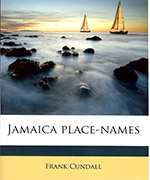
This is a very short book with only 9 pages describing the place names but I thought it was interesting because it was one of the first attempts to collect the place names of Jamaica. Cundall had access to many historic documents in the Institute of Jamaica which he uses in his description of the place names derived from the Spanish names, named after Governors and by Soldiers of fortune. He quotes Long's History of Jamaica and adds scripts to the names. The whole is given in a chatty manner interspersed with some lists. The first page is a list of the regulations of the Institute, how many books members and subscribers could borrow, art and photography classes and office hours. There are slight imperfections as one would expect in a reprint of this type but they are not overwhelming. This book does not compare to the in depth study highlighted in Feb 2014 (below)which is extensive in its coverage, but as an historical artifact it is of interest.
![]()
![]() Return to Home Page or use your "Back" button if you entered from the Worldgenweb page or continue on to previous sources
Return to Home Page or use your "Back" button if you entered from the Worldgenweb page or continue on to previous sources
![]() Devon House Families by Enid Shields Kingston, Jamaica: Ian Randle Publishers Ltd 1991 pp 136, Family trees, Bibliography, Maps. ISBN 978-976-637-612-3
Devon House Families by Enid Shields Kingston, Jamaica: Ian Randle Publishers Ltd 1991 pp 136, Family trees, Bibliography, Maps. ISBN 978-976-637-612-3
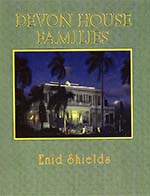
There are 7 Chapters in this book. The first is devoted to the Rectors of the St Andrew Parish Church who owned the Glebe land Devon House was built on and established a Rectory. The Second is on George Stiebel the son of a Jamaican housekeeper and a German Jew who bought the rectory and lands from the Church of England in 1879 and built Devon House on the rectory foundations in 1881. His family lived in it until 1923. His life is detailed in the book and some pictures of him are available. His daughter Therese married Richard Jackson and the Stiebel Jacksons took over the house told in Chapter 3. One of their grand children married into my family and is still alive in Canada, so I was interested in the history of this family. Chapter 4 is about the Melhado family. Reginald Melhado was an entrepreneur who bought Devon House in 1923. His was a large family but four of his eight children died early. He and his family lived in it until 1928 when it was bought by Cecil Lindo. Chapter 5 relates to Cecil's family and how he died there in 1960. Cecil made his money in Costa Rica in Bananas sold out his properties in 1909 to the United Fruit Company for 5 million dollars. He fixed up the house and did a lot of entertaining. He and his wife Irene were the last private owners of Devon House. Due to to the intervention of Edward Seaga the house was bought when it was due to be developed and the beautiful house was preserved. The last two chapters detail the changes and how it was for a time an Art Gallery and now is a place for receptions and dinners. The Appendices give a list of the St Andrew Church rectors, A chronology of events of Devon, Family Trees, House plans of the building, and plans for further development, as well as the Bibliography. Many black and white pictures of the interior and exterior of the house are included.
![]() Jamaican Place Names by B.W. Higman and B.J. Hudson Kingston, Jamaica: University of the West Indies Press 2009 pp 319, Foot notes, Bibliography, Index, Maps. ISBN 978-976-640-217-4
Jamaican Place Names by B.W. Higman and B.J. Hudson Kingston, Jamaica: University of the West Indies Press 2009 pp 319, Foot notes, Bibliography, Index, Maps. ISBN 978-976-640-217-4
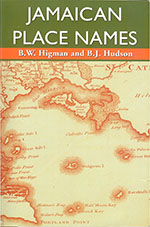
The Preface of this book introduces it with the sentence: "This book is a study of the place names of Jamaica and of what they can tell us about the history and culture of the island". The first chapter, Place names and History, starts with an Anecdote:"One afternoon in June 1988 family and friends filled a small church at Dundee in the district of Maroon Town,parish of St James, western Jamaica, and waited patiently for the commencement of the funeral of Jane Reid. Meanwhile the hearse carry her body was on the way to Dundee in the neighouring parish of Westmoreland, fifty kilometers away, the drivers from the funeral home having mistaken this to be their proper destination. The service started two and a half hours late. Apart from the Dundee of Westmoreland, the drivers of the hearse might have set out for Dundee in Trelawny, the neighbouring parish to the east, or even a Dundee in Hanover the parish to the west. Why so many Dundees in Jamaica?". The book sets out to answer this question as a study in place hames.
This book supplements the work of Inez Sibley Dictionary of Place Names in Jamaica (see May 1997 below) and the authors also used the Encyclopedia of Jamaican Heritiage by Olive Senior (see October 2007 below) for reference. If you are looking for a place in Jamaica the index will help you find it and the many maps, hand drawn of places with the name, are comprehansive. The databases the authors draw their studies from include maps and survey place names from 1680, 1760, 1800, 1880, and 1950. The second chapter relies on the fact that many of the place name givers were from many lands, and this chapter describes their origins from Europe, UK, Africa and Asia. There are also chapters on naming for Topography, Hydrological names, Coastal, Enterprise, Settlement, Route names, but I find the second chapter most useful because of the diversity of the ancestors homelands and how they gave names to places. The most common place name in Jamaica is "Content" where there are 28 such places. Gimme-me-bit, District of Look behind, and Me No Sen You No Come are unique. The authors claim that this book is for the scholar as well as the general reader. I use it mainly to verify names of places on which I get queries and you will find it useful for knowing why your ancestors home was given the name it was.
No book in January
![]() World's Fair: Jamaica at Chicago. An account Descriptive of the Colony of Jamaica, with Historical and Other Appendices by Charles James Ward, Compiler New York: W. J. Pell, 1893, Reprint by Nabu Public Domain Reprints, 96 pp, Appendecies, no index, map of Jamaica
endpiece
World's Fair: Jamaica at Chicago. An account Descriptive of the Colony of Jamaica, with Historical and Other Appendices by Charles James Ward, Compiler New York: W. J. Pell, 1893, Reprint by Nabu Public Domain Reprints, 96 pp, Appendecies, no index, map of Jamaica
endpiece
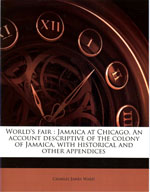
In October 1998 (see below) I wrote about this book: "Photographs made in the 1890's of the towns and countryside of Jamaica illustrate this slim little book which was written to encourage tourists and others to visit the island and presented at the World's Fair [Columbian Exposition] in Chicago in 1893. Jamaica was quite well prepared for this exhibition because it had had its own Exhibition in 1891. The chapters include, a descriptive account of the parishes of Jamaica, Columbus and Jamaica, Later History, Sport in Jamaica, The Blue Mountains of Jamaica, the Climate of Jamaica and Statistical Information about Jamaica. I like this book chiefly for its wonderful black and white photographs of the 1890's."
This is a new edition in paperback made by scanning the original. As the reprinters note there are imperfections in this edition which were either in the original that they used for scanning eg markups, or missing pages (1) or errors introduced in the scanning process eg grainy pictures. Unfortunately the pictures look more like they are in a newspaper that the photographs I praised in the original I had borrowed from a library in 1998. Still this edition is worth having in your library if you are interested in knowing what Jamaica was like in 1893. Charles Ward, the compiler, was the Col. Ward who gave Kingston the Ward Theatre. He was a Commissoner at the 1893 World's Fair for Jamaica.
![]() Old Saint Jago (1896) by George Fortunatus Judah Kingston, Jamaica: W.A. Feurtados' Sons, Printers, 1896, Reprint by Kessinger Legacy Reprints, 56 pp, Appendix, no index
Old Saint Jago (1896) by George Fortunatus Judah Kingston, Jamaica: W.A. Feurtados' Sons, Printers, 1896, Reprint by Kessinger Legacy Reprints, 56 pp, Appendix, no index
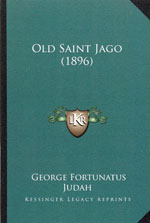
This book was based on a lecture the author gave to a select group (whom he thanks in the preface) in 1884 and covers in nine chapters the history of Saint Jago de la Vega or Spanish Town. Judah was among other things a genealogist and wrote some pieces in the style of the New England Genealogical Society. That is a great mixture of interesting paragraphs on places and people. In this book he traces from the time of the Spanish rulers of the island to the present time (1884) when the capital had recently moved from Spanish Town to Kingston. Thus some of the glory of Spanish Town had been lost. Judah was very much against this move and the piece reflects his biases. He does give a little bit of personal history since he was brought up in Spanish Town and his father was established there. Chapter nine is devoted to some of the famous people buried in the Cathedral in Spanish Town which includes Governors, Beckfords, Archers, Beeston, Pennants, Carey, Colepepper, Collyer, James, Lewises and Lynches, etc.,etc. He drops names in lists like the above, but does not go into much detail on most of them. He describes the first day of the inauguration of a new Governor, an opening of the Annual meeting of the Legislature, and reproduces from the Royal Gazette of 1795 the investiture of Sir Adam Williamson with the Order of the Bath all at Spanish Town, and the pageantry of the occasion. An appendix describes the funeral of the Countess of Effingham who was descended from the Beckfords.
![]() The Barretts of Jamaica:The Family of Elizabeth Barrett Browning by Robert Assheton Barrett Winfield, Kansas: Wedgestone Press and London:The Athlone Press, 2000 212pp ISBN 0-485-30042-7
Index,color illustrations, pedigree.
The Barretts of Jamaica:The Family of Elizabeth Barrett Browning by Robert Assheton Barrett Winfield, Kansas: Wedgestone Press and London:The Athlone Press, 2000 212pp ISBN 0-485-30042-7
Index,color illustrations, pedigree.
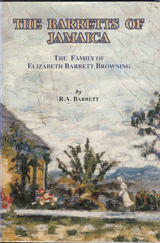
This is the story of the Barrett family from the late 1600's when Hercy or Hercie Barrett went from England to the West Indies with Penn and Venables to the year 2000 in Jamaica.This Barrett family is the family of Elizabeth Barrett Browning but does not have a great deal about her life in particular, except as she known as "Ba", writes to relatives and about her brother "Bro" who did go to Jamaica. It is not an easy read because it does quote extensively from correspondance and from legal documents including wills in the language and punctuation (i.e. none) of the day. But it does illustrate how Jamaican families got embroiled in the Courts with law suits that lasted for years! In this case the suit went on for over 40 years and arose from a will in dispute over land and slaves. The second reason that it is difficult to read is the repetition of first names(Richard, Samuel etc) from generation to generation of Barretts and extended family. That is why the pedigree which is included is so useful. A Barrett married a Moulton and later Moulton descendants took on the extra name Barrett, so some of the family had Barrett Moulton-Barrett as their last names. The story continues through the end of slavery and traces how this rich family fell into decline after the fall of the sugar trade in Jamaica and sold their properties the main one being Cinnamon Hill in St James.It is at Cinnamon Hill that the founders of the large family fortune were buried. I was personally interested in references to the small property Retreat Pen in St Ann, because my Uncle at one time owned it, and my father had a smallpiece of land from it when he retired. Sadly the Retreat house is now pulled down, but I remember it well as a child.
![]() The Baptists of Jamaica by Inez Knibb Sibley The Jamaica Baptist Union: Kingston, Jamaica. 1965 91pp Some illustrations.
The Baptists of Jamaica by Inez Knibb Sibley The Jamaica Baptist Union: Kingston, Jamaica. 1965 91pp Some illustrations.
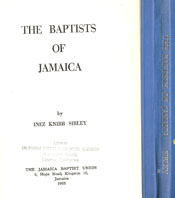
In May 1997 (see below) I put on this site Miss Sibley's Dictionary of Place Names in Jamaica. This is another book that she published. As you can see she was related to Rev Knibb a famous Baptist minister of Jamaica. The present book describes the history of the Baptists from George Liele (See July 2005 below) and Moses Baker up to 1965 when the book was written. The first part of the book encompasses the early beginnings, the role of the Baptists in obtaining land for the freed slaves, the building of Calabar for training Baptist clergy, the missions to Africa and other West Indian islands and the role in Education. The second part of the book details the ministers in the different parishes with many names listed and how the Baptist churches were established. So if your ancestor was a Baptist minister before 1965, this book may mention him and describe his work. There are a few pictures of ministers and of places. Although there is a short list of references there is no index, but if you know the parish you can easily focus on that part of the book. My copy of the book is an ex-library copy bought on the used book market. I think it is out of print, but a library may have it.
![]() A Struggle to walk with Dignity: The True Story of a Jamaican-born Canadian by Gerald A. Archambeau 2008 pp 278, Toronto, Ontario: Blue Butterfly Books ISBN 978-0-9784982-0-7.
A Struggle to walk with Dignity: The True Story of a Jamaican-born Canadian by Gerald A. Archambeau 2008 pp 278, Toronto, Ontario: Blue Butterfly Books ISBN 978-0-9784982-0-7.
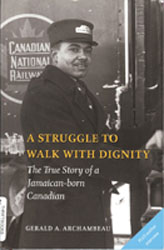
In June 2010 I posted a book about the immigrant experience in Britain (Small Island). The present book concerns the Jamaican immigrant experience in Canada. The author was born in Kingston and raised by aunts, so the first part of this autobiography deals with life in Kingston in the 1930's and early 1940's. (Interesting reading for those who never lived in Kingston during this period) In 1947 he immigrated to Canada to Montreal to his mother and stepfather. He worked in a variety of jobs in Montreal after training for the plumbing and steam fitting trade. At eighteen he then got a job as a porter with the Canadian Pacific Railway and then the Canadian National Railway, seeing the entire width of the country from the Maritimes to the Pacific. After Railroad traffic declined he joined Air Canada, working in Toronto. For a few years he returned to Jamaica to help Air Jamaica with improving its ramp management, but returned to Toronto and retired to live in St Catherine's, Ontario. His book chronicles his experiences with discrimination and how he dealt with the day to day treatment on the job. He is fair and upbeat about how far Canada has progressed. With black and white photographs and an index.
No posting since June 2011
![]() Roving with Lalah:Slices of Everyday Jamaica Life by Robert Lalah 2008 pp 121, Kingston, Jamaica: Ian Randle Pub. ISBN 978-976-637-363-4
Roving with Lalah:Slices of Everyday Jamaica Life by Robert Lalah 2008 pp 121, Kingston, Jamaica: Ian Randle Pub. ISBN 978-976-637-363-4
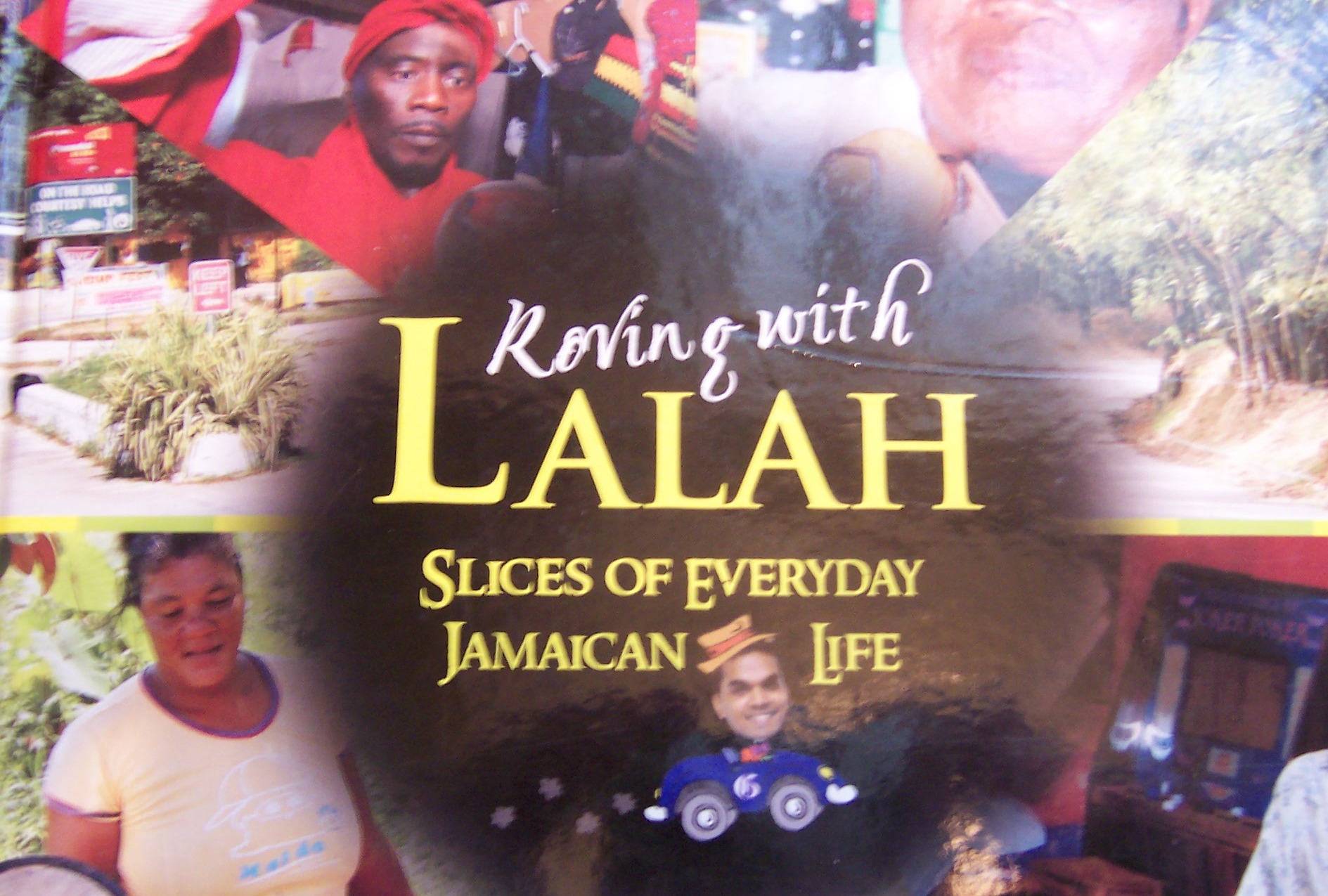
A delightful book written by a roving reporter of "The Gleaner" Newspaper, Kingston, Jamaica. There are 31 stories with Photographs about rural, non-Kingstonian Jamaica. Many visits to places involve duppies (or ghosts), and also there are encounters with Jamaican Cab drivers in New York, Jamaica and London. Port Royal, Bath, Salt River, Shirley Castle, Mocho Mountain and Middle Quarters are some of the places he asks the inhabitants what they think of their part of the Island.
No posting since January 2011
![]() The Railways of Jamaica - Through the Blue Mountains to the blue Caribbean seas: a History of the Jamaica Government Railway by Jim Horsford 2010 pp 168, St Austell, Cornwall UK: Paul Catchpole Ltd ISBN 978-1-900340-20-5
The Railways of Jamaica - Through the Blue Mountains to the blue Caribbean seas: a History of the Jamaica Government Railway by Jim Horsford 2010 pp 168, St Austell, Cornwall UK: Paul Catchpole Ltd ISBN 978-1-900340-20-5
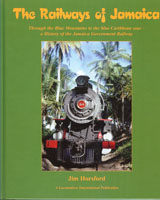
This book caught my eye, not because I have a lot of family who worked on the Railway, (in fact I can only think of one distant cousin), but because of the anecdotes of my maternal and paternal grandfathers. My paternal grandfather came to Jamaica in 1890 from Southampton, England and in order to reach his teaching post at York Castle, St Ann had to take the train from Kingston to Ewarton and then a buggy ride from Ewarton over Mt Diablo to Moneague and so to York Castle which was not in Brown's Town at the time but in the Pedro area. It must have been quite an experience for the new graduate of Cambridge University. My maternal grandfather helped to build the Frankfield bridges and viaducts on the extension from May Pen to Frankfield. We have some pictures taken of this time, probably in the 1920's. He had been an apprentice on the Forth Bridge near Edinburgh, Scotland in the 1890's.
When we lived at Grove Place during WWII the railway line ran just east of the house and twice a day "Passenger!!" would pass as well as other activity on the line. It was memorable to a 4 year old. I remember my mother said she got Bread from Montego Bay during this time. I suspect now that only Bakeries could get sufficient flour becuse flour was imported and boats from Canada were scarce during the War. I can vividly remember the "to-do" about the Kendal crash (which was September 1 1957), the worst train disaster in Jamaica. You can "google" it. I think I only took two trips on the train, one in about 1944 to Montego Bay from Grove Place and one from Kingston to Williamsfield in the 1950's. Again in the 1950's we saw the Banana trains coming into Port Antonio to load the banana Boat the Golfito we travelled on to England.
Back to the Book. It is beautifully illustrated with over 300 pictures and maps and gives the history of the locomotives, it is a Locomotives International Publication. Unhappily the railway closed in 1992, except for the Bauxite lines, although it was a tourist attraction. Some of the stock left on the line is now overgrown with bush and trees. The book would be enhanced by an index, but the table of contents is quite extensive. The Appendices give data on the Active and Inactive lines, The Tunnels on the lines and a list of the Location and Conditions of the Stations in 2003/4
No posting since June 2010
![]() Martha Brae's Two Histories: European Expansion and Caribbean Culture-Building in Jamaica by Jean Besson 2002 pp 393, Chapel Hill and London: University of North Carolina Press ISBN 0-8078-5409-3 paperback
Martha Brae's Two Histories: European Expansion and Caribbean Culture-Building in Jamaica by Jean Besson 2002 pp 393, Chapel Hill and London: University of North Carolina Press ISBN 0-8078-5409-3 paperback
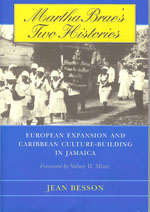
This very scholarly book is written by a social anthropologist and so may be quite difficult for some family historians. There are however several chapters which I think all will find pertinent. In particular when she relates her field work of personal interviews with descendents who knew of their slave ancestors and the "Family Land" and its culture in the community around Martha Brae near Falmouth, Jamaica. Her explanations about "Family Land" in semi-rural Trelawny, how it could not be divided, even in wills, because it was land occupied by the ancestor former slave after emancipation, and how all descendents (whether they lived in Martha Brae or elsewhere including abroad) could claim access to the land to live on or to gather fruits and produce, was new to me. It also detailed family groups of these descendents. She also discusses the religious beliefs and practices of the villagers. She also has a chapter on the European settlement of Martha Brae, so if your ancestors were from Martha Brae/Falmouth, this will be an interesting book. The author documents her work with numerous references to others work,and anthropological theory which makes for difficult reading in some parts, but she also has illustrations including her own photographs, extensive Notes and Bibliography and good index.
No posting since February 2009
![]() Small Island: A Novel by Andrea Levy. 2004 pp 441, New York, Picador. (Paperback) ISBN 0-312-42467-1 . Published in Great Britain by Headline Book Publishing.
Small Island: A Novel by Andrea Levy. 2004 pp 441, New York, Picador. (Paperback) ISBN 0-312-42467-1 . Published in Great Britain by Headline Book Publishing.
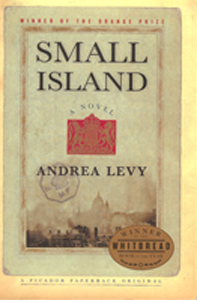
I usually do not post novels on this site, but this novel by Andrea Levy, a second generation Jamaican immigrant, has a great contribution to understanding the immigrant experience of the Jamaican in England that I thought it should be included in this family history selection. The book is set in post-WWII England 1948, and tells the story of Gilbert and Hostense, two Jamaicans who leave the Island and go to England to enhance their opportunities in life. Gilbert has served in England in the Armed forces in the War, and Hortense has trained as a teacher in Jamaica. Their life in London is intertwined with that of their landlady Queenie from Yorkshire and her husband Bernard who has served in India during the War. The hopes and aspirations of the Jamaican couple and how they are dealt with by the people they interact with in Britain are treated in flashback and current passages. To detail any more would spoil the story. The book has been made into a TV movie and has been shown on the BBC and on PBS in the United States and is available on DVD. The Author won the Whitbread Book of the Year Award,the Orange Prize and the Commonwealth Writers'Prize for this novel.
No posting since November, 2008
![]() The Knell of Parting Day: A History of the Jews of Port Royal and the Hunt's Bay Cemetery by Marilyn Delvante. Published by the Author, printed in China by Regent Publishing Services Ltd, 2008 pp 214. ISBN 978-976-8217-30-1 Hardback. It is also available in paperback. ISBN 978-976-8217-29-5
The Knell of Parting Day: A History of the Jews of Port Royal and the Hunt's Bay Cemetery by Marilyn Delvante. Published by the Author, printed in China by Regent Publishing Services Ltd, 2008 pp 214. ISBN 978-976-8217-30-1 Hardback. It is also available in paperback. ISBN 978-976-8217-29-5
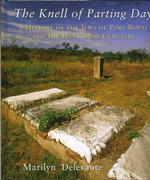
This book is the second by the author pertaining to the Jews of Jamaica (see February 2006 below). She has greatly expanded the work of Barnett and Wright (see January 1998 below) for the Hunt's Bay cemetery by including translations of all the languages (Portuguese, Spanish and Hebrew as well as English) on the 163 tombstones which were existing when pictures of the tombs were taken. She begins with the location of the cemetery and Historical migration of the Jews to the Caribbean and goes on to the history of Port Royal including the 1692 earthquake. There are two chapters on the Jews of Port Royal and Spanish Town, followed by 64 pages of the inscriptions, translations and photographs of the graves. This is completed with a discussion of the cemetery art and a synopsis of the genealogy of the people found in the Cemetery and descendents of Port Royal Jews. Some of the names discussed in detail include:Aguilar, Baruh Alvares, da Costa Alvarenga,De Lucena,Ferro, Gabay, Mendes Gutteres,Nunes and Nunes Gonsales, Suiero and Lopez Torres, not all of whom have Jewish descendents today because of marriage outside of Jewish families. Some of the descendents of treated in some detail are the Brandons and deCordovas The book has notes, a glossary, bibliography and index including names. I see copies of this book on Amazon March 2015 are no longer available.
No posting since November, 2007
![]() In Old St James (Jamaica):A Book of Parish Chronicles compiled by Joseph Shore and edited by John Stewart. The Bodley Head: London, 1st edition 1911, 2nd edition 1952, pp 118
In Old St James (Jamaica):A Book of Parish Chronicles compiled by Joseph Shore and edited by John Stewart. The Bodley Head: London, 1st edition 1911, 2nd edition 1952, pp 118
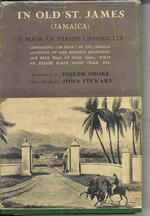
The title of this book continues: Containing the story of the Jamaican Ancestry of Mrs Barrett Browning; the True Tale of Rose Hall; what an Estate Slave Book Tells, etc. The Book starts with a chapter on Arawak Remains and Spanish Documents and ends with an appendix on a list of slaves on the Rose Hill (sic) Estate and a list of Regulations to be observed in Boiling Houses Etc from Rose Hall Estates Journal December 31, 1828. In between are Chronicles of the English settlement and estate evolution, Estates in St James from 1770-1832, and After emancipation. Later chronicles report the Laurence family 1676-1910,Rose Hall and the "true" Annie Palmer story, and the Barretts of Cinnamon Hill.The cover shows Rose Hall estate in the early 19th century and the book has several early 20th century black and white photographs of the properties. Also included is a black and white portrait of Edward Barrett. The slave lists (1832) include the Old name, Christian names if any, Creole or African, Colour, age, Valuation, occupation, Condition and Disposition (Good, Indolent or Runaway).
No posting since January, 2007
![]() Enclyclopedia of Jamaican Heritage by Olive Senior Twin Guinep Publishers Ltd, St Andrew, Jamaica W.I. 2003, 549 pp ISBN 976-8007-4-1
Enclyclopedia of Jamaican Heritage by Olive Senior Twin Guinep Publishers Ltd, St Andrew, Jamaica W.I. 2003, 549 pp ISBN 976-8007-4-1
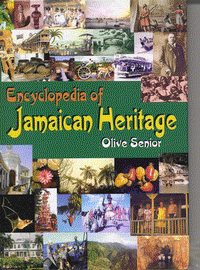
The earlier volume by this author on this topic may be seen under the posting on this page in December 1997 as A-Z of Jamaican Heritage published in 1983. This new book is greatly expanded with many new pieces, pictures and drawings. The subject index in the front of the book is divided into 8 parts and subjects listed alphabetically and includes:the natural world,economic life,cultural activities,domestic and leisure activities, folklore, historic people, historic events, and historic places. Art and art history is covered all in the format of an enclyclopedia. Modern literature and writers as well as earlier authors are covered. With nearly 1000 entries and 700 illustrations this book answers many questions about Jamaican culture and Heritage. If you have a place name in Jamaica be sure to look it up. A map of modern Jamaica is included as well as a bibliography for further study.
No posting since November, 2006
![]() Pieces of the Past: A Stroll Down Jamaica's Memory Lane by Rebecca Tortello Ian Randle Publishers, Kingston, Miami 2007, 280pp ISBN (paperback) 976-637-268-3 and 978-976-637-268-2
Pieces of the Past: A Stroll Down Jamaica's Memory Lane by Rebecca Tortello Ian Randle Publishers, Kingston, Miami 2007, 280pp ISBN (paperback) 976-637-268-3 and 978-976-637-268-2
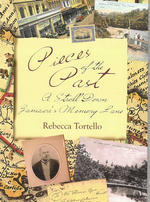
You may know that the Gleaner Newspaper website carries a series called"Pieces of the Past" by Rebecca Tortello, well, hot off the press, most of them have been pulled together in Book form and published by Ian Randle, publishers. Genealogists and family historians will probably be particularly interested in the section on "The People who Came" which includes, Africans, English, Scots and Welsh, Jews, Chinese, Indians, Lebanese, Germans and Irish. But other sections on "Trials: Natural and Manmade" (earthquakes, hurricane, Kendal Railway disaster, etc) "Jamaicans who served" (including Mary Secole, Claude McKay, Cicely Williams and Thomas Lecky, WWI and II, etc)will also be of interest. "Places" such as Port Royal, Spanish Town, Falmouth and Kingston have pieces and "Cultural Heritage" covers Devon House,Ward Theatre, Tom Cringle's Cotton Tree demise, Weddings and Christmas and other articles. Other sections including 'A Nation Emerges" and "Famous Visitors" are important for the historical background they give. Lastly "Things Jamaican" include articles on Coffee, Rum, Birds, Breadfruit and the Botanical Gardens. All these historical articles are beautifully illustrated, some in colour, courtesy of the Gleaner Company and the National Library of Jamaica. Sources are given at the end of each article. The Table of contents lays out the pieces included very well, but it would have been nice to have an index to make it complete. The book is also available in hardcover.
No posting since May, 2006
![]() Who's Who, 1957, Jamaica, West Indies: An Illustrated Biographical Record of Outstanding People in Jamaica with a Supplement of Persons in the Federation who Helped to Bring about Closer Union of the West Indies Territories by Clifton Neita, Editor Who's Who Jamaica Ltd: Kingston, Jamaica. Printed by the Gleaner Co. Ltd. 1957, 520pp
Who's Who, 1957, Jamaica, West Indies: An Illustrated Biographical Record of Outstanding People in Jamaica with a Supplement of Persons in the Federation who Helped to Bring about Closer Union of the West Indies Territories by Clifton Neita, Editor Who's Who Jamaica Ltd: Kingston, Jamaica. Printed by the Gleaner Co. Ltd. 1957, 520pp
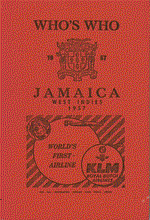
This series of books started in 1916 and has been published periodically since that time up until the 1980's I believe. The Royal Commonwealth Society Library (Cambridge University Library, Cambridge, England), holds the following editions: 1916 (1st edition), 1921, 1924 (3rd), 1941-46, 1951 (7th), 1954 (8th). These are very useful tools if your ancestor was prominent enough to be a J.P. (Justice of the Peace), businessman, clergy, etc. and was not limited to being an expatriate colonial civil servant, although many of the latter are listed. They often give the names of the father and mother of the person. The 1916 first edition has pictures of people and also lists persons who had recently died, in 1909 for example. This 1957 edition also has an obitury section. This edition is particularly interesting because of the references to the Federation of the West Indies which eventually failed. I bought this edition on the antiquarian market, some of the early editions are only available as rare books for appropriate prices on the market. Patricia Jackson on her site (members page)has extracted the 1916 edition, but that is the only on-line source as yet. The later series are still in copyright.
Thanks to Robert Scholnick. No posting since February 2006.
![]() Jamaica in 1850, or The Effects of Sixteen Years of Freedom on A Slave Colony by John Bigelow, introduction by Robert J Scholnick Urbana and Chicago: University of Illinois Press 2006 256pp ISBN 0-252-07327-4.
Jamaica in 1850, or The Effects of Sixteen Years of Freedom on A Slave Colony by John Bigelow, introduction by Robert J Scholnick Urbana and Chicago: University of Illinois Press 2006 256pp ISBN 0-252-07327-4.
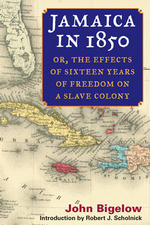
After Jamaican slaves were fully emancipated in 1838, the local economy collapsed. Driven by a belief in the innate inferiority of the black race and bolstered by this apparently disastrous Jamaican example, Americans who defended slavery convinced many that emancipation at home would lead to economic and social chaos. Collecting John Bigelow's vivid firsthand reporting, Jamaica in 1850 challenges that widely held view and demonstrates that Jamaica's troubles were caused not by lazy blacks but by the incompetence of absentee white planters operating within an obsolete colonial system. Bigelow also shows that although large plantations languished, many former slaves worked tirelessly and became successful small-scale landowners.
John Bigelow (1817-1911) was an editor at the New York Evening Post and an organizer of the Free-Soil party. Robert J. Scholnick is a professor of English and American studies at the College of William and Mary. His introduction places the book within transnational debates about Emancipation, slavery, colonialism, and economic development in the antebellum period and considers its powerful impact in furthering the antislavery cause.
No posting since November, 2005
![]() The Island of one People: An account of the History of the Jews of Jamaica by Marilyn Delevante and Anthony Alberga Kingston and Miami:Ian Randle Publishers 2006 223pp ISBN 976-637-212-8.
The Island of one People: An account of the History of the Jews of Jamaica by Marilyn Delevante and Anthony Alberga Kingston and Miami:Ian Randle Publishers 2006 223pp ISBN 976-637-212-8.
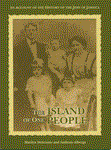
Delevante and Alberga have carried forward the history and descriptions of Andrade (see this page October, 1997) into the beginning of the 21st Century of the Jews in Jamaica. Thus more recent history, details of the synagogues, cemeteries and their present conditions are included. Biographies of Jewish personalities and Merchants are described and specific treatment is given to eight families in separate chapters namely the Lindo, deLisser, Myers, deCordover, Ashenheim, Henriques, Matalon and Alberga familes. Allied families are also discussed. Those who are interested in Jamaicans Jews who were freemasons and some persons who went to Panama will also find sections informative. The book is beautifully illustrated with copies of documents or black and white photographs on practically every page, well annotated and indexed. This has become a rare book. On Amazon in March 2015, it was listed as Paperback $378 and Hardcover $2904
![]() Moravian Misssionaries at Work in a Jamaican Slave Community, 1754-1835 by Richard S. Dunn James Ford Bell Lectures Number 32. University of Minnesota: The Associates of the James Ford Bell Library 1994, 25 pp
Moravian Misssionaries at Work in a Jamaican Slave Community, 1754-1835 by Richard S. Dunn James Ford Bell Lectures Number 32. University of Minnesota: The Associates of the James Ford Bell Library 1994, 25 pp
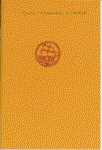
This lecture of 21 pages summarizes the role of the Moravian missionairies at Mesopotamia a sugar estate in Westmoreland which was owned by the Barham family. The following of slaves at Mesopotamia was never very large, but was maintained over a period of 80 years. This piece explains why the congregation was never large and was older. Although there are no slave lists the 4 page bibliography does have references to papers at Oxford (and elsewhere) that were in the possession of the Barhams. No illustrations or index because it is a short piece obtained through Amazon
![]() Tracing Your West Indian Ancestors by Guy Grannum Public Record Office Readers Guide No 11. PRO, Kew, Surrey, 2nd Edition, 2002 pp 194. ISBN 1 903365 38 4
Tracing Your West Indian Ancestors by Guy Grannum Public Record Office Readers Guide No 11. PRO, Kew, Surrey, 2nd Edition, 2002 pp 194. ISBN 1 903365 38 4
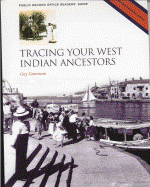
The second edition of Guy Grannum's book came out in 2002. This was before the PRO changed its name to The National Archives, Kew, so it is still called the Public Record Office Readers Guide No 11. While this book is for the whole of the West Indies, it is very helpful for the records pertaining to Jamaica which are held in the National Archives, Kew, England. Specifics of the call numbers for resources are on page 144-147 for Jamaica. But the preceeding chapters explain what is in the resources. It has been updated and expanded from the first edition so that it is particularly helpful for the beginner and explains the Slave resources and military resources very well. The bibliography leads to sources for other West Indian Islands, which were pathways to Jamaica for some people.
None in August 2005
![]() Transients to Settlers: The Experience of Indians in Jamaica 1845-1950 by Verene Shepherd . University of Warwick and Peepal Tree Press: Leeds, England 1993. ISBN 0-948833-32-7 pp281, tables,figures,bibliography,index.
Transients to Settlers: The Experience of Indians in Jamaica 1845-1950 by Verene Shepherd . University of Warwick and Peepal Tree Press: Leeds, England 1993. ISBN 0-948833-32-7 pp281, tables,figures,bibliography,index.
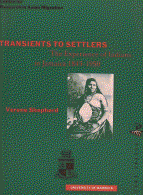
Part of a Thesis submitted to the University of the West Indies, Mona, this book was also summarized in an Article in the Jamaica Journal Vol 18, 1985. As the author points out the East Indian population of Jamaica was smaller than that of Trinidad and Guyana so has been written about less often. The 8 chapters include an overview, Indians as Indentured settlers, Transients to settlers, Economic Activities and socioeconomic conditions of Indian Settlers, Missionary Activities,Education and perhaps the most interesting Social Customs and Institutions and pressure to Conform. In the latter marriage, divorce and disposal of the dead are treated. An execellent bibliography and index are included with each chapter having notes and references. There are several tables and figures with for example economic data, a map of where in India indentured labourers were recruited, and where immigrants from one ship were sent to Estates in Jamaica. While some of this may seem dry, academic approach the prose is very readable and makes the picture of this group of immigrants more understandable. It would have been nice to have some photographs in this book.
None in June 2005
![]() George Liele: Pioneer Missionary to Jamaica by Clement Gayle. Kingston, Jamaica: Jamaica Baptist Union. 1982/3. Bibliography, Appendix. 47 pp.
George Liele: Pioneer Missionary to Jamaica by Clement Gayle. Kingston, Jamaica: Jamaica Baptist Union. 1982/3. Bibliography, Appendix. 47 pp.
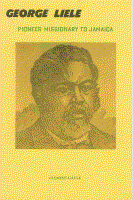 Written for the bi-centenial celebration of the Baptist establishment in Jamaica, this book describes the role that George Liele played in establishing the Baptists in Jamaica. He was a freed Slave from America and came to Jamaica in 1783 where he started to preach and baptize the slaves and ex-slaves in Kingston and surroundings. This book establishes that Liele and his followers were responsible for inviting the English Baptist Mission to send representatives to the island who arrived in 1814. The appendix lists the convenant the early baptists had. The text suggests why this early leader has been overlooked in the past.
Written for the bi-centenial celebration of the Baptist establishment in Jamaica, this book describes the role that George Liele played in establishing the Baptists in Jamaica. He was a freed Slave from America and came to Jamaica in 1783 where he started to preach and baptize the slaves and ex-slaves in Kingston and surroundings. This book establishes that Liele and his followers were responsible for inviting the English Baptist Mission to send representatives to the island who arrived in 1814. The appendix lists the convenant the early baptists had. The text suggests why this early leader has been overlooked in the past.
None since November 2004
![]() A List of Emigrant Ministers to America, 1690-1811 by Gerald Fothergill. Bowie, Md. Heritage Books. 2002. ISBN 0-7884-2153-0. Reprint of edition London 1904. 65 pp
A List of Emigrant Ministers to America, 1690-1811 by Gerald Fothergill. Bowie, Md. Heritage Books. 2002. ISBN 0-7884-2153-0. Reprint of edition London 1904. 65 pp
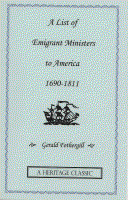 This short little book is as the title says a list of Church of England Ministers and Teachers who were sent to the Americas and Caribbean from England. Although there are not a lot of Jamaican entries there are enough that it warrants inclusion in a list of sources of family history, especially for those whose forebears were clergyman or school teachers. The list is derived chiefly from money books, King's Warrants Books, Treasury Papers and Exchequer of Receipt Papers all preserved in the National Archives (formerly the Public Record Office) Kew, England. These records derive from money given the applicant to proceed to the colonies. There are quite a few entries for other West Indian Islands and for Bermuda. Note that the entries cease in 1811, so that you cannot expect to find ancestors leaving England after that time. Introduction of 5 pages by the compiler.
This short little book is as the title says a list of Church of England Ministers and Teachers who were sent to the Americas and Caribbean from England. Although there are not a lot of Jamaican entries there are enough that it warrants inclusion in a list of sources of family history, especially for those whose forebears were clergyman or school teachers. The list is derived chiefly from money books, King's Warrants Books, Treasury Papers and Exchequer of Receipt Papers all preserved in the National Archives (formerly the Public Record Office) Kew, England. These records derive from money given the applicant to proceed to the colonies. There are quite a few entries for other West Indian Islands and for Bermuda. Note that the entries cease in 1811, so that you cannot expect to find ancestors leaving England after that time. Introduction of 5 pages by the compiler.
Nothing since February 2004
![]() A Journey Through Time in Jamaica : the story of AC Campbell & his ancestors. by Donna R. Campbell-Kenny. Markham, ON : Stewart Publishing, 2003. 316 ; ill, charts.
A Journey Through Time in Jamaica : the story of AC Campbell & his ancestors. by Donna R. Campbell-Kenny. Markham, ON : Stewart Publishing, 2003. 316 ; ill, charts.
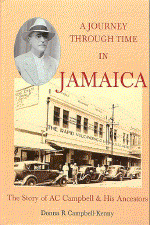
Donna Campbell-Kenny, an expatriate Jamaican living in Australia, has spent many years researching her Jamaican family history and this book represents the fruits of that extensive research. This is not only a family history but also a history of the island and of how it shaped the people who inhabit this account. Using original records, newspaper accounts and recollections of the descendants of A. C. Campbell, Donna Campbell-Kenny has brought to life the story of the different familes with which her family is connected. It is also a history of the Rapid Vulcanizing Company, a business that many expatriate Jamaicans are familiar with. The book contains numerous photographs and family charts which help to clarify the various relationships discussed. As well as being a portrait of a family in Jamaica over many years it also serves as an excellent example for any family historian who is planning to record their own family history.
Nothing since July 2003
![]() The Western Design: an account of Cromwell’s expedition to the Caribbean. by S. A. G. Taylor. London : Solstice, 1969, c1965. (Originally published by the Institute of Jamaica and the Jamaica Historical Society, 1965.) xii, 242 p. : ill., maps.
The Western Design: an account of Cromwell’s expedition to the Caribbean. by S. A. G. Taylor. London : Solstice, 1969, c1965. (Originally published by the Institute of Jamaica and the Jamaica Historical Society, 1965.) xii, 242 p. : ill., maps.
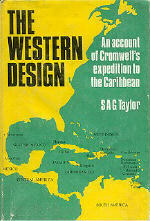
S. A. G. Taylor, a former President of the Jamaica Historical Society and engineer in the Jamaica Civil Service, has written a scholarly and readable account of the capture of Jamaica in 1655 and how it came about. Oliver Cromwell’s grandiose Western Design was conceived as a scheme to conquer the Spanish possessions in the Caribbean. The original objective was the capture of the island of Santo Domingo. To this end Cromwell commissioned Admiral Penn and General Venables to put together an army of recruits (from Barbados and St. Christopher) and sail to Santo Domingo. However, the attack was repulsed and rather than return empty-handed, the expedition went on to Jamaica, landing on 10 May 1655. Some days later the Spanish Governor surrendered, though for quite some time the Spanish fought a guerrilla action to repel the English invaders.
Taylor recounts the story of the invasion, the subsequent struggles of an ill-equipped and untrained force to hold the island, the valiant resistance of the Spanish patriots along with their loyal slaves, and the perseverance of the English soldiers who managed in the end to win victory. Part of his information is based on documents concerning Jamaica in the Archivo de India at Seville, discovered in 1916-17 by Miss I . A. Wright and transcribed by the Institute of Jamaica, as well as The Narrative of General Venables, edited by C. A. Firth, the Thurloe State Papers, and the Calendar of State Papers.
![]() Slaves and Missionaries: The Disintegration of Jamaican Slave Society, 1787-1834 by Mary Turner Kingston, Jamaica: The Press University of the West Indies, 1998, pp 223. Paper back:ISBN 976-640-045-8.Previously published Urbana, Illinois: University of Illinois Press 1982
Slaves and Missionaries: The Disintegration of Jamaican Slave Society, 1787-1834 by Mary Turner Kingston, Jamaica: The Press University of the West Indies, 1998, pp 223. Paper back:ISBN 976-640-045-8.Previously published Urbana, Illinois: University of Illinois Press 1982
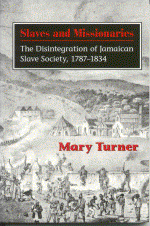
The paperback edition of this book has seven chapters. The first two chapters describe firstly the status and mind-set of the non-conformist men (ie not Church of England/Anglican/Episcopalian) who went to Jamaica as missionaries and secondly, the status of slaves and briefly their religious beliefs drawn from Africa. The next two chapters describe how the missionaries interacted with the slaves and how this interaction influenced the process which led to emancipation. The influence of the Missionary societies on the antislavery politic is explained. The fifth chapter uses the Methodist missionary experience to show how religion influenced the slaves in their fight for freedom and the sixth chapter describes the period of 1831-1834 using the Baptist missionaries role in the largest Rebellion (1831) of that time. Sam Sharpe the National Hero is discussed briefly. The last chapter describes how freedom was actually achieved. If you have Methodist or Baptist missionaries or slave ancestors of the period 1823-34 this is a very compelling book. Although the title suggests a longer time period the meat of the book concentrates on the last decade before emancipation. The parts of the island referred to in more depth include St Ann, Trelawny and St James and Hanover etc.,that is the County of Cornwall and St Ann from Middlesex. There are two maps, one of the Mission stations in 1834 and the second of the estates involved in the 1831 Slave Rebellion. The are many footnotes and an excellent bibliography. There are no illustrations except for the cover which is a reprint of a Duperly print of the Attack of the Rebels on Old Montpelier in 1831.
None in April and May
![]() City of Kingston souvenir : commemoration of the bicentennial of the city charter, 1802-2002.
by Johnson, Anthony S. Kingston : ISKAMOL, 2002
City of Kingston souvenir : commemoration of the bicentennial of the city charter, 1802-2002.
by Johnson, Anthony S. Kingston : ISKAMOL, 2002
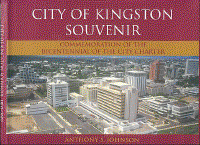
The history of the city of Kingston dates from 1692 and the destruction of Port Royal by earthquake when the town was established on lands purchased from William Beeston. However, the actual charter creating the corporation of the City of Kingston dates from 1802 and it is the bicentennial of this charter that Johnson celebrates in this book. Beginning with a chronology of the city's history he continues with a description of the history of city government from the days of the Vestries, the various Mayors and councils, and the growth and dvelopment of this vibrant city, the port of Kingston, and the various business enterprises. Throughout the book is copiously illustrated with historical black and white and more recent colour photographs. The book also includes a usefull bibliography.
![]() Historic Jamaica from the Air by David Buisseret Kingston, Jamaica: Ian Randle Publishers. 1996, pp 150. ISBN 976-8100-64-8.
Historic Jamaica from the Air by David Buisseret Kingston, Jamaica: Ian Randle Publishers. 1996, pp 150. ISBN 976-8100-64-8.
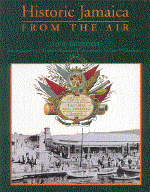
This second edition of Historic Jamaica from the Air in addition to a history of Jamaica has many maps, historic prints of Hakewill and Kidd as well as aerial photographs of many locations that are described in the text.
The history starts with the Taino and continues to the present day 20th century. Since there are two editions, this latter edition is able to contrast late 1960's aerial photographs with early 1990's pictures. Several old plantations houses and ruins are shown as well as aerial views of how the sugar estates and coffee plantations are/were laid out. Many views, ports and towns and bays are shown in beautiful colour photographs. A good biography and short index are included.
![]() The Iron Thorn: The Defeat of the British by the Jamaican Maroons by Carey Robinson Kingston: LMH Publishing, 1993 pp 273, ISBN 976-610-159-0
The Iron Thorn: The Defeat of the British by the Jamaican Maroons by Carey Robinson Kingston: LMH Publishing, 1993 pp 273, ISBN 976-610-159-0
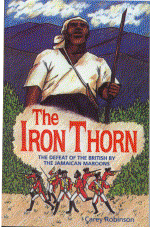
This account of the two Maroon wars is taken from first hand accounts and written in a very personable way. Thus you feel you know the person being discribed whether Maroon or British. Since these battles were the only wars fought on Jamaican soil, they are interesting.
The sympathies of the writer lie with the Maroons and many aspects deal with their bravery and betrayal. The narrative also deals with the final banishment to Nova Scotia and eventually the transfer to Sierra Leone in 1800. Since there are some in the island who can claim descent from the Maroons, this is a great addition to family history. Several drawings, prints from paintings and maps in black and white illustrate this book.
None in December 2002
![]() Culture and Customs of Jamaica by Martin Mordecai and Pamela Mordecai Westport, Connecticut: Greenwood Press, pp 217. ISBN 0-313-30534-X
Culture and Customs of Jamaica by Martin Mordecai and Pamela Mordecai Westport, Connecticut: Greenwood Press, pp 217. ISBN 0-313-30534-X
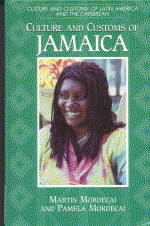
This book will be of interest to those who have never been to Jamaica, but heard much about the culture, art, music, etc. While it starts off with an abbreviated history from the Taino to the present day, most of the book is devoted to the 20th century and is very good on developments since independence in 1962.
It traces particularly the African influences on much of the culture, but includes other influences as well. Chapters include: religion, education, language, social customs (food and festivals), media and cinema, literature, music, performing arts and visual arts. In the visual arts section many Jamaican artists are named and their birthdates given. There are several pages of black and white photographs of architecture, sculptures and dance. An eleven page bibliography and index round out the book.
![]() A History of Jamaica from its discovery by Christopher Columbus to the year 1872: including an account of its trade and agriculture, sketches of the manners, habits and customs of all classes of its inhabitants, and a narrative of the progress of religion and education in the island by W. J. Gardner. London: T. F. Unwin, 1909. Reprinted, London: Frank Cass, 1971, 510pp (Cass Library of West Indian Studies, No 17) ISBN 0 7146 1938 8
A History of Jamaica from its discovery by Christopher Columbus to the year 1872: including an account of its trade and agriculture, sketches of the manners, habits and customs of all classes of its inhabitants, and a narrative of the progress of religion and education in the island by W. J. Gardner. London: T. F. Unwin, 1909. Reprinted, London: Frank Cass, 1971, 510pp (Cass Library of West Indian Studies, No 17) ISBN 0 7146 1938 8
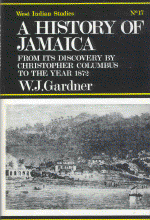
This history of Jamaica covers the post emancipation period in the 19th century up to 1872. It is divided into five Periods: Discovery by Columbus and Spanish Occupation, From the conquest by the English 1655 to the great earthquake 1692, From the Earthquake to the commencement of the Anti-slavery struggle 1782, From the Commencement of Anti-slavery to emancipation and From emancipation to 1872.
Each period except the last is divided into chapters which cover Historical events, Commerce and Agriculture, Religion and Education and Manners and Customs. My edition has a 1905 map. There are no illustrations and no index.
![]() A Jamaican Plantation: the history of Worthy Park 1670-1970
by Michael Craton and James Walvin. Toronto: University of Toronto Press, 1970, 344pp. ISBN 0 8020 1727 4
A Jamaican Plantation: the history of Worthy Park 1670-1970
by Michael Craton and James Walvin. Toronto: University of Toronto Press, 1970, 344pp. ISBN 0 8020 1727 4
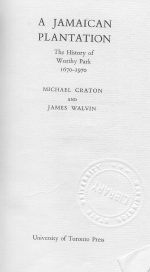
Worthy Park is a sugar plantation in St John’s district of St. Catherine. This book contains genealogical information on the Price family, as well as the life of slaves and landowners continuously for 300 years. It has a pedigree chart of the Price family history.
Several black and white photographs of the estate are included in the 17 illustrations. The endpieces include a list of slaves and a list of the increase and decrease in the 1780's. The appendix includes a list of the years supplies received at Worthy Park in the year 1789. See also The Invisible Man (June 1997, below) and Henry Clarke (May 2002, below).
![]() The Annals of Jamaica by George Wilson Bridges London: John Murray, 1827-28. Reprinted, London: Frank Cass, 1968. (Cass Library of West Indian Studies, No 1) New Impression: 1968, 2 Volumes, 600+ pages each.
The Annals of Jamaica by George Wilson Bridges London: John Murray, 1827-28. Reprinted, London: Frank Cass, 1968. (Cass Library of West Indian Studies, No 1) New Impression: 1968, 2 Volumes, 600+ pages each.
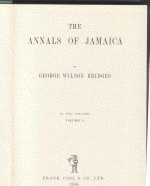
A two volume set, this history is drawn mostly from the records of the House of Assembly. It is very dry and preachy with minimal characterization of people. Its chief interest is that its author, the Rev. Bridges was Anglican Rector of St. Ann during the abolition of Slavery. He was for the planters and rabidly anti-abolitionist which is reflected in his writing.
He played a role in the persecution of the non-conformist clergy who were trying to help the newly freed slaves. Some interesting appendices, for example the fees for various services of the church, for each parish the worth of the incumbancy, the number of burials, the number of proprietors in the parish.
None in June and July
![]() Caribbeana: being Miscellaneous Papers relating to the History, Genealogy, Topography and Antiquities of the British West Indies edited by Vere Langford Oliver, Member of American Antiquities Society, corresponding Member New England Historical Genealogical Society. 1909-1916, 6 vol.
Caribbeana: being Miscellaneous Papers relating to the History, Genealogy, Topography and Antiquities of the British West Indies edited by Vere Langford Oliver, Member of American Antiquities Society, corresponding Member New England Historical Genealogical Society. 1909-1916, 6 vol.
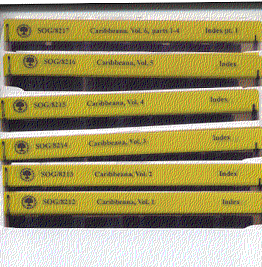
No longer available on Microfiche from the Society of Genealogists, London but Brian Littlewood in the UK has produced two CD's for the 6 volumes and two supplements at this email address. Jim Lynch in Canada has republished archival sets of 8 volumes (with indexes)Check here.
Because Mr. Oliver examined many sources in England and Jamaica from which he extracted information for this work, this genealogical reference is very useful. There are pedigrees and tentative pedigrees which he evolved of people from Jamaica, especially from 1655 to 1800. The format is similar to that of The New England Historical and Genealogical Register, with pedigrees, wills and other records intermixed in different volumes. Vere Oliver had a helper in this endeavour, a Mrs. Verona T.C. Smith who kept hand written notes and extracts of the work including pedigrees. Approximately 43 volumes of these notes were turned over to the Soc of Genealogists. They have been microfilmed (negative film) but not indexed in a comprehensive index, each volume had a separate index. I did not have a great deal of time to examine the films, so I am not sure how much additional information is available which was unpublished in Caribbeana (See K Ingram, Sources of Jamaican History, below, for further information on this source).
![]() The Life and Times of Henry Clarke of Jamaica-1828-1907 by James Walvin Frank Cass, Portland: Oregon 1994 pp 155. ISBN 0-7146-4551-6.
The Life and Times of Henry Clarke of Jamaica-1828-1907 by James Walvin Frank Cass, Portland: Oregon 1994 pp 155. ISBN 0-7146-4551-6.
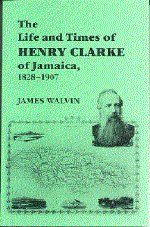
The Rev. Henry Clarke kept diaries, 6 volumes of them, and it is from these volumes that the narrative is derived. He came out to Jamaica from England as a school teacher at Manning's Free School in Sav-la-Mar, but was shortly ordained as a Anglican Minister. He lived and worked in the Western Parishes except when he became a Legislator. His wife who was also English had 11 children and his diaries are often about his family life. One of Henry's achievements was starting the Building Society in Sav-la-Mar, although he often pursued other projects consisting of various inventions. His descendents include Miss Edith Clarke, the sociologist, and the Managing Director of the Gleaner Co. This is an interesting view of a Victorian in Jamaica, in some ways a very stubborn man, but with a good heart. It would be wonderful if all our ancestors had kept diaries!
![]() Vale Royal: the House and People by Enid Shields Kingston, Jamaica:Jamaican Historical Society.
1983 pp 74.
Vale Royal: the House and People by Enid Shields Kingston, Jamaica:Jamaican Historical Society.
1983 pp 74.

Vale Royal is a property in St Andrew that originally belonged to Col Henry Archbould 1669 or his relative James. In 1980 it became the home of the Prime Minister, the Edward Seaga. In between it was occupied by the Colonial secretaries 1929-1959, and from 1962 the Finance Ministers. Before it was sold to the Government in 1929, the home belonged to following families: Archbould, Lascelles, Lawes, Luttrell, Mitchell, Taylor, Bayley, Aikman, Gordon, Murray, Jackson, Scotland, Nuttall, Goegahan. There is a plan of the estate in 1813 and several pictures of the interior in 1983,some occupiers and their contemporaries. Some of the early families and the later occupants are described from sources in the archives and biographies. Sources are listed. Very interesting not only for those whose ancestors lived there, but also as an illustration of what can be found in the archives of deeds of houses and wills.
![]() Jamaica's heritage: an untapped resource: a preservation proposal by Tourism Action Plan Limited, in collaboration with the Jamaica national Heritage Trust.
by Marcus Binney, John Harris, Kit Martin. Editor: Marguerite Curtin. (Kingston: The Mill Press, 1991). 100 p., ill. (some col.), maps. plans. ISBN 976 8092 90 4.
Jamaica's heritage: an untapped resource: a preservation proposal by Tourism Action Plan Limited, in collaboration with the Jamaica national Heritage Trust.
by Marcus Binney, John Harris, Kit Martin. Editor: Marguerite Curtin. (Kingston: The Mill Press, 1991). 100 p., ill. (some col.), maps. plans. ISBN 976 8092 90 4.
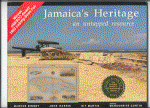
Jamaica has a wealth of historic, artistic and environmental heritage. This well illustrated book describes in detail the many historical buildings, estates and routes throughout the island which are being preserved for the future. Several restoration programs are in progress in Falmouth, Port Royal, Spanish Town and New Seville. There are throughout photographs of the various historic estates on the heritage trail across the island. This book has a wide appeal. It will be invaluable to the family historian, the historical researcher, the environmentalist, the architectural student, and the lover of Jamaica's flora and fauna. The following quote from the Chairman's Note, by the Hon. Maurice W. Facey, Tourism Action Plan Ltd. says it all:
"In March 1990, the Binney, Harris, Martin team came to Jamaica under the auspices of Tourism Action Plan Limited to share their expertise in the preparation of this publication. Their time and effort was a gift to this nation in recognition of our country's historic and artistic heritage which, along with the natural environment, they believe to be Jamaica's most valuable tourism product...It is in this context that we hope this report will stimulate all Jamaicans to understand the importance and value to Jamaica of the preservation of the island's many remarkable historic areas, such as Port Royal, Spanish Town, Falmouth, Rio Bueno, New Seville; the significance and the promotion of its art, theatre, music, dance and ethnic traditions."
![]() The Economy and Material Culture of Slaves: Goods and Chattels on the Sugar Plantations of Jamaica and Louisiana by Roderick McDonald. Baton Rouge, Lousiana State University Press, 1993, 339 pp. ISBN 0-8071-1794-3
The Economy and Material Culture of Slaves: Goods and Chattels on the Sugar Plantations of Jamaica and Louisiana by Roderick McDonald. Baton Rouge, Lousiana State University Press, 1993, 339 pp. ISBN 0-8071-1794-3
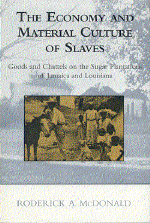
This book has four chapters, two devoted to Jamaica and two to Lousiana. The data for Jamaica are chiefly drawn from the Old and New Montpelier plantations (St James) which had about 300-400 slaves. The first chapter concerns how slaves obtained money and the third chapter on how they spent it.
In Jamaica the source of money was in selling produce and crafts in the market on Sunday. Slaves had provision grounds which they worked on their day off (except in cane harvest time) to produce the fruits and vegatables they sold. They also raised pigs and poultry which they sold. They mainly spent their earnings on food and clothing.
The author describes from plantaion ledgers what can be gleaned of the holdings of slaves at least in 1825 a few years before emancipation. He compares and contrasts it to holdings of the slave population in Louisiana up to the Civil War. This book is not just a statistical survey it does give a feel for the everyday life of slaves. There are also some illustrations in black and white which are drawn not only from Jamaica but also other Caribbean islands and Lousiana. Extensive appendixes list the original data on which the study is drawn.
No Sources posted October - December 2001
![]() The White Minority in the Caribbean. Edited by Howard Johnson & Karl Watson Chapter 6. The White Minority in Jamaica at the end of the Nineteenth Century by Patrick Bryan. 1998 pp.116-132. Ian Randle, Kingston, Jamaica Publishers. Jamaica ISBN:976-8123-10-9. James Curry, United Kingdom ISBN:0-85255-746-9. Markus Wiener, Princeton, NJ ISBN: 1-55876-161-6.
The White Minority in the Caribbean. Edited by Howard Johnson & Karl Watson Chapter 6. The White Minority in Jamaica at the end of the Nineteenth Century by Patrick Bryan. 1998 pp.116-132. Ian Randle, Kingston, Jamaica Publishers. Jamaica ISBN:976-8123-10-9. James Curry, United Kingdom ISBN:0-85255-746-9. Markus Wiener, Princeton, NJ ISBN: 1-55876-161-6.
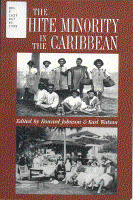
As you can see this book covers the entire Caribbean and not just Jamaica. In fact the chapters covering other islands are often more comprehensive than the chapter covering Jamaica. However since it treats a subject from a difference perspective from about 1850 to the early 1900's it is a useful.
Several prominent families particularly merchants of the time are mentioned. The Jews and the Scots are picked out for some discussion of the diversity among the white families. The chapter treats some of the institutions originating in this era by whites. The relationship between the ex-patriate and local whites is explored. The bibliography of the chapter shows that several Daily Gleaner (Newspaper) excerpts are used. Published in Jamaica, UK and US so there are different ISBN numbers.
![]() Spanish Town: The Old Capital by Clinton Black The University Press, Glasgow, 1960, 63pp
Spanish Town: The Old Capital by Clinton Black The University Press, Glasgow, 1960, 63pp

This short little book was commissioned by the St Catherine Parish council with the aid of Clinton Black who was the Archivist of the Island records. The two end pieces are maps, one of Jamaica and the other of Spanish Town itself. The books describes the history of the town, during the Spanish period and the British Period as well as Spanish Town today (1960). It discusses the buildings in the Square, including the Old Record Office and Archives, the Court House and the old Kings House, as well as the Cathedral, the Barracks and the Spanish Town Baptist Church.
It ends with some places of Interest Near Spanish Town including Ferry, Tom Cringles Cotton Tree (since deceased I understand) and the Arawak Village which used to be a Museum (now closed), and Colbeck Castle. There are some very nice photographs of the town and other places mentioned in the book. A handy little book if you want to get a flavour of the old capital.
![]() Wonderful Adventures of Mrs Seacole in Many Lands by Mary Seacole, introduced by William Andrews. Reprinted by Oxford University Press as part of the Schomburg Library of 19th Century Black Women Writers, 1988, 200 pp. ISBN 0-19-506672-3
Wonderful Adventures of Mrs Seacole in Many Lands by Mary Seacole, introduced by William Andrews. Reprinted by Oxford University Press as part of the Schomburg Library of 19th Century Black Women Writers, 1988, 200 pp. ISBN 0-19-506672-3
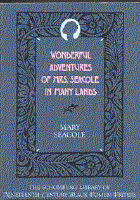
This small little book is part of the collection of the Schomburg Library of ninetheenth century Black Woman Writers. Mary Jane Grant Seacole was the daughter of a Scottish army officer and a Black boarding house keeper. She married Mr Seacole but he died very shortly after they were married. She went to Panama and some of her book is devoted to this phase of her life, but most of it is of her experiences as a nurse and boarding housekeeper in the Crimea during the Crimean war.
Since there are very few books written by women, Black or Creole of this time this is interesting for the light it throws on life for many of the inhabitants. However Mary Seacole was a unique woman for the amount of travelling she did, she was also very persistant and amazingly sucessful when she was in the Crimea when she became a respected maternal figure to the British soldiers far away from home.
![]() Whence the 'Black Irish' of Jamaica by Joseph J. Williams New York, Dial Press 1932, 97 pp.
Whence the 'Black Irish' of Jamaica by Joseph J. Williams New York, Dial Press 1932, 97 pp.
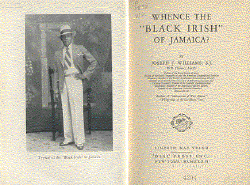
This book attempts to find the roots of many Black Jamaicans who have Irish surnames. Claims have been made that 1000 Irish women and girls and boys were sent to the Island by Cromwell and that that is how there are many Irish surnames in the Island. The book does not give evidence that Cromwell ever carried out his intentions, in fact it says that we have to leave it open to later explorations to find evidence of this. However the author goes on to explore the possiblity that they came from Barbados with Penn and Venebles and later with other leaders who came from Barbados to Jamaica. This book does not explore the Irish who came as overseers and book keepers and others who came in the 19th century. Three photographs and a Bibliography.
![]() Roots and Blossoms by Edmund Davis Bridgetown, Barbados: Cedar Press, 1977, 124 pp.
Roots and Blossoms by Edmund Davis Bridgetown, Barbados: Cedar Press, 1977, 124 pp.

Roots and Blossoms is about the history of the Anglican church in Jamaica. The early chapters cover the period before a bishop was appointed to the island in 1824. After that there are several chapters devoted to how the church coped with the lack of ministers and the early attempts to train upper class creoles to fulfill the clergy needed to meet parish needs.
Quite a few chapters are devoted to the establishment of St Peter's Theological College and the many trials that were encountered. His main critisism is that the early curriculum was so dictated by the traditional classical background expected in English Public Schools (Greek and Latin) and not enough emphasis on the practical aspects and cultural forms of the people to whom they were going to administer. Few of the early applicants who were native Jamaicans therefore were matriculated into the College. He ends at the time the United Theological College was founded at the UWI, Mona in 1966.
![]() Historic Jamaica by Frank Cundall Published for the Institute of Jamaica by the West India Committee, London, 1915, 424 pp.
Historic Jamaica by Frank Cundall Published for the Institute of Jamaica by the West India Committee, London, 1915, 424 pp.
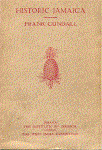
This old book which I got on the antiquarian market is a delightful mix of history, travelogue and some genealogy. It is arranged by parish. Cundall deals with the History from the Spaniards to 1915 when he visits a parish. He then tells of the places of historic interest. Often this includes the church and description of the monuments to which genealogies are added.
There is liberal quotation from old documents. There are explanations of the origin of some place names. The book is illustrated in black and white with prints and sketches. A good index. Frank Cundall was instumental in building up the Institute of Jamaica, so he had access to some of the really valuable references for Jamaican History prior to the beginning of the 20th century.
![]() The Portuguese Jews of Jamaica. by Mordechai Arbell. Jamaica:Canoe Press, 2000, 70pp. ISBN 976-8125-69-1.
The Portuguese Jews of Jamaica. by Mordechai Arbell. Jamaica:Canoe Press, 2000, 70pp. ISBN 976-8125-69-1.
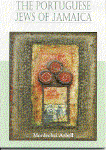
This slim little volume available from Barnes & Noble takes us from the Portuguese Jews who settled Jamaica during the time of the Spanish occupation to early in the 20th century. It is richly developed with black and white illustrations.The chapters include the Jews of Port Royal, Jewish settlements of Jamaica, Jewish rights and disablitities as well as Jewish economic activities.
The last chapter under the heading Cultural life deals briefly with the lives of noteworthy Jews. There is a short list as an illustration of Jews in Jamaica and Barbados in the late 1600's. A list of cemetaries taken from other sources is listed in the appendix. Though it does not add a great deal to the other Jewish sources listed on this site, it is interesting for its illustrations of the synagogues of Kingston and its bibliography.
![]() The Lindo Legacy by by Jackie Ranston. (London: Toucan Books, 2000). ISBN 1-903435-00-5. 144 p., ill., plates, (some col.), geneal. tables.
The Lindo Legacy by by Jackie Ranston. (London: Toucan Books, 2000). ISBN 1-903435-00-5. 144 p., ill., plates, (some col.), geneal. tables.
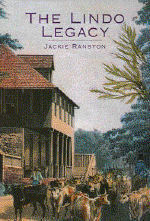
The Lindo Legacy traces the fortunes of a prominent Jamaican Sephardic Jewish family, from the Spanish and Portuguese Inquisitions, through their travels from Amsterdam to London, and then to Jamaica.
The book was commissioned by Blanche Lindo Blackwell and is meticulously researched. While not a definitive history of the Sephardic Jews in Jamaica, It is a fascinating study of how one Sephardic family settled there and made its fortune, first in Kingston, then in Falmouth, and eventually in Costa Rica.
![]() Genealogy of Jamaica compiled by Donald Lindo compact disk from the Compiler, Kingston, Jamaica. 3rd edition, 2000.
Genealogy of Jamaica compiled by Donald Lindo compact disk from the Compiler, Kingston, Jamaica. 3rd edition, 2000.
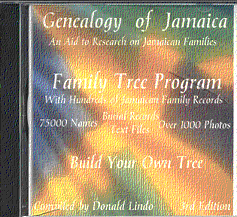
This compact disk is the 3rd edition of Donald's compiliation of Geneology of Jamaica. It contains 75,000 names of Jamaica, 24,730 marriages and 1136 photos and 178 text files. The database includes burials from St Andrew Parish Church and many notations from Who's Who of Jamaica which were extracted by Donald. There are also many contributions from individuals. The basic database is run on the genealogy program Brother's Keeper (a Shareware program), an easy program to learn. Although written for a PC, there is also a Gedcom file on the CD for those who want to access this information using a different genealogy program including a Mac. You can order the CD on-line through Donald's Web page.
No Sources posted October-December,2000
![]() A Short History of Portland by Beryl M. Brown. Jamaica: Ministry of Education Publications Branch, PO Box 498, Kingston, Jamaica 1976, 48 pp
A Short History of Portland by Beryl M. Brown. Jamaica: Ministry of Education Publications Branch, PO Box 498, Kingston, Jamaica 1976, 48 pp
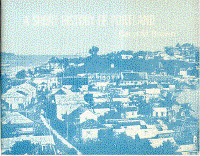
This short book was published for use in elementary schools in Jamaica. It treats the Maroons in Portland, Sugar production in Portland, the Banana Trade and Tourism, the Rivers of Portland, including the Rio Grande and rafting. In "People and Places in Portlands history" it treats a few of the most famous places, including Manchioneal. On Machioneal it says,"This is now an important district in Portland. It was the scene of some adventures which Michael Scott wrote about in his story Tom Cringle's Log. At Muirton, there is an old great house to which Tom is said to have been taken when he landed from Cuba with yellow fever." The people it discusses are Thomas Clement Darlington Geddes and Frederick M. Jones. Lorenzo Dow Baker is pictured. There some nice black and white photographs, including one of Muriton Great House, and line drawings and three maps. A one page index is included.
![]() Early Baptist Beginnings by C.S.Reid. Jamiaca Journal Vol 16, No 2, pp 2-8, 1983
Early Baptist Beginnings by C.S.Reid. Jamiaca Journal Vol 16, No 2, pp 2-8, 1983
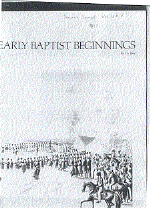
In 1983 the Baptist celebrated 200 years of work in Jamaica and this article tells of their early beginnings. This includes the ministries of George Liele, a Black originally of Virginia, Moses Baker, John Rowe, William Knibb and James Phillippo. The Role of the Baptists in the antislavery effort and in the education and spiritual leadership of the ex slaves is examined. Pictures include a rare woodcut of George Liele, a picture of William Knibb holding the declaration of the Abolition of Slavery, a portrait of the Rev James Phillippo after whom Phillippo Baptist Church in Spanish Town is named.
Included also are the East Queen Street Baptist church in Kingston and the Annotto Bay Baptist Church. Various other monuments are depicted and a short list of references is given.
![]() They Came from the Middle East by Nellie Ammar.Jamiaca Journal Vol 4, No 1, pp 2-6, March 1970
They Came from the Middle East by Nellie Ammar.Jamiaca Journal Vol 4, No 1, pp 2-6, March 1970
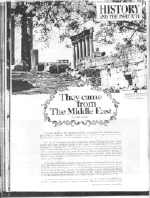
This article from the Jamaica Journal is written by a descendent of one of the Lebananese who came to Jamaica, Nellie Ammar. Nellie's Father Shehadie Khaleel Melick was known as Mr Khaleel because of the practice the first immigrants used of not using their last names. Often the second name of a person was the name of his father. Nellie says that most of the very early immigrants came from the small town of Schweifat in Lebanon.
In Jamaica, the early Lebananese became known as Syrians because Lebanon was then part of Syria. Among the families she lists as early immigrants are Hanna, Issa and Matalon. Her article gives some details on why the early immigrants chose Jamaica and what they did when they got to the island.
![]() Jamaican Labor Migration: White Capital and Black Labor, 1850-1930. by Elisabeth McLean Petras. Boulder and London:Westview Press, 1988, 297 pp. ISBN 0-8133-7456-1
Jamaican Labor Migration: White Capital and Black Labor, 1850-1930. by Elisabeth McLean Petras. Boulder and London:Westview Press, 1988, 297 pp. ISBN 0-8133-7456-1
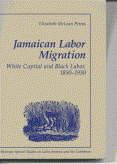
If your ancestors went to Panama or Cuba to work, this book has something for you. It is a social history of the labour movement. Although it concentrates on the banana plantations and The canal in Panama, it also relates about merchants who went to Panama and who passed through Panama on their way to other destinations.
About 38,800 Jamaicans went to Cuba between 1921 and 1933 to work on sugar estates, before that from 1912 to 1920 it is estimated about 75,000 Jamaicans went to Cuba. They went for work. The book chronicles the build up and collapse of the labor markets and the reasons for the lack of work in Jamaica at the time. The book is part of the Westview Special Studies on Latin America and the Caribbean. It has a substantial bibiliography, tables and a few graphs.
None in April or May
![]() Women in Caribbean History. compiled and edited by Verene A Shepherd. Ian Randle, Publishers, James Currey, Oxford, Markus Weiner, Princeton, 1999 pp189. ISBN 976-8123-64-8
Women in Caribbean History. compiled and edited by Verene A Shepherd. Ian Randle, Publishers, James Currey, Oxford, Markus Weiner, Princeton, 1999 pp189. ISBN 976-8123-64-8

This book is an attempt to bring together scattered information on Women in Caribbean History from various ethnic backgrounds. The book covers examples from all the islands but a great deal of the information is from Jamaica. Some of the chapters are Indigenous Caribbean Women, Enslaved women, European women pre-emancipation, free women of color, emigration in the 19th and 20th century and more recent activities of women in the late 19th and 20th centuries.
There are short paragraphs about specific women and many illustrations and maps. The book is for students teachers and the general reader and gives a different perspective than most histories of the islands.
![]() Jamaican Records- A Research Manual: a Two Part Guide to Genealogical & Historical Research using repositories in Jamaica & England. by Stephen D. Porter Compiled and published by Stephen Porter, England. ISBN 0-9536356-0-0. email: moneagueuk@yahoo.co.uk
Jamaican Records- A Research Manual: a Two Part Guide to Genealogical & Historical Research using repositories in Jamaica & England. by Stephen D. Porter Compiled and published by Stephen Porter, England. ISBN 0-9536356-0-0. email: moneagueuk@yahoo.co.uk
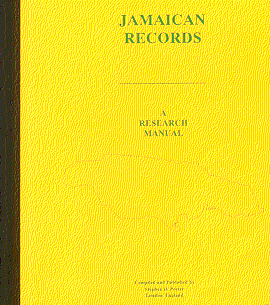
This research Guide is a succinct aid to research sources in England and Jamaica for doing Jamaican Family History research, particularly for those in London, England and in Jamaica. The first part of the slim volume is on Records in Jamaica and the second part covers Records in England. Some of the items overlap, e.g. newspapers which are found in both Jamaica and England.
A good description of history of the parishes and how they were instituted is given Part 1, p2-3. In English repositaries, Part 2, Stephen lists the holdings of the Genealogists'Magazine which pertain to Jamaica, including several peoples Names, which are available at the Society of Genealogists, London. Also given is a description of the principal sections of Caribbeana by volume, there are 6 volumes. This short review does not do sufficient justice to the wealth and detail given in this manual. A "must-have" item for your bookshelf. Cost is only BP 6.95 plus shipping and postage (Sept 1999).
![]() Columbus and the Golden World of the Island Arawaks by D.J.R. Walker.
Sussex, England: The Book Guild Ltd. 1992, pp 320. ISBN 0-86332-686-2
Columbus and the Golden World of the Island Arawaks by D.J.R. Walker.
Sussex, England: The Book Guild Ltd. 1992, pp 320. ISBN 0-86332-686-2

Although few if any Jamaicans can trace their families back to the Arawaks (no documentation) the history of this period is interesting to those who want to know what the land and people were like before the Europeans came. This book calls the People of Jamaica the Island Arawaks, as part of the family of the Taino people who were found in the other islands of the Greater Antilles. Now they are commonly referred to as the Taino. They used a similiar language.
The Author concentrates on the first two voyages of Columbus because that is when there are good descriptions in the translated Spanish Records of the life of the native people. The last chapter describes the destruction of the people in Hispaniola and by inference in other islands where the Spanish ruled. Nice old prints and a good bibliography for the period.
![]() The Development of Creole Society in Jamaica, 1770-1820 by Edward Brathwaite
Oxford: Clarendon Press 1971,374 pp.
The Development of Creole Society in Jamaica, 1770-1820 by Edward Brathwaite
Oxford: Clarendon Press 1971,374 pp.
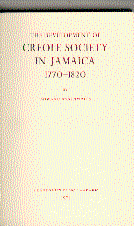
Mr Braithwaite wrote this book first as a doctoral thesis at the University of Sussex, England in 1968. It is an "historical study with socio-cultural emphasis, seeking to understand the workings of a 'Creole' society during the central period of British West Indian Slavery". In a central section of the book he describes the institutions of the whites, the free coloured with privileges and those without privileges and the slaves.
There is a section on Jamaican 'folk' culture. The appendix is interesting. It includes a list of slaves on Worthy Park estate in 1789, a record of conversations between two slaves and a missionary on the topic of marriage, and a list of the slave laws 1770-1817.
![]() Sir Hen Morgan: Buccaneer and Governor by W. Adolphe Roberts
Kingston: The Pioneer Press 1952, paperback 163 pp.
Sir Hen Morgan: Buccaneer and Governor by W. Adolphe Roberts
Kingston: The Pioneer Press 1952, paperback 163 pp.
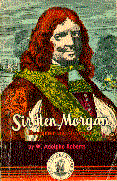
This little paperback published in 1952 is probably out of print, however it might be available from libraries. It starts with the sentence, "Sir Henry Morgan rose in five years from obscurity to be lord of the buccaneers that scourged the Spanish Main". He lived in Port Royal so there is a short description of the town in the 17th century.(The wickedest city in the World)
He was born of Welch stock in the year 1635 and died aged 53 years in Jamaica. He rose to be Lt-Governor of Jamaica after he stopped bucaneering. He had no descendants but left his estate to his wife's nephew, the Byndloss family on the condition that he take the name of Morgan. The Morgan-Byndloss name only survived in Jamaica up to 1755. The book has several illustrations in black and white but no index.
![]() Slave Population and Economy in Jamaica, 1807-1834 by B.W. Higman.
Cambridge: Cambridge University Press, reprint paperback 1976, pp 327 ISBN 0-521-21053-4
Slave Population and Economy in Jamaica, 1807-1834 by B.W. Higman.
Cambridge: Cambridge University Press, reprint paperback 1976, pp 327 ISBN 0-521-21053-4

This book covers the period after the law which prohibited the slave trade from Africa to the West Indies in 1807 continuing to the abolition of slavery in 1834. In one of the chapters he traces pedigree's of slaves from the Slave returns of certain estates. He deals with manumissions and runaways.
The author uses statistical treatment for many arguments. The appendix A1.1 shows weights and measures and monetary value for many items in Jamaica in 1832. Well documented.
![]() Journal of a West India Proprietor:kept during a residence in the Island of Jamaica by Matthew Lewis
Oxford: Oxford University Press, reprint paperback 1999, pp 294 ISBN 0--19-28326-1
Journal of a West India Proprietor:kept during a residence in the Island of Jamaica by Matthew Lewis
Oxford: Oxford University Press, reprint paperback 1999, pp 294 ISBN 0--19-28326-1

For a first hand account of life on a plantation in 1815-8, this book is especially valuable. Matthew Lewis also known as Monk Lewis was renowned for the novel he authored, and the way he tried to improve the living and working conditions of the slaves on his two plantations, one in St Thomas in the East and the other in Westmoreland.
He was judged a humane slave holder however he leaves out of the chronicle, things which bring him less credit. This Oxford University Press edition is well documented and a map shows the location of the plantations.
![]() The Dynamics of Change in a Slave Society: a Sociopolitical History of the Free Coloreds of Jamaica, 1800-1865 by Mavis C. Campbell
London: Associated University Presses, 1976, pp 393 ISBN 0-8386-1584-8.
The Dynamics of Change in a Slave Society: a Sociopolitical History of the Free Coloreds of Jamaica, 1800-1865 by Mavis C. Campbell
London: Associated University Presses, 1976, pp 393 ISBN 0-8386-1584-8.
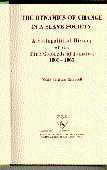 .
.
The extended title is :A sociopolitical History of the Free Coloreds of Jamaica, 1800-1865. So for the researcher who is interested in the history of this era, or of the free coloured people, this is a good source. This book is not illustrated except for 2 maps at the back. (One map is of the extent of the Morant Bay Rebellion of 1865).
The first appendix lists the governors during the time period covered. An extensive bibliography could lead you to other published sources.
No sources were posted in June or July
![]() The Cruise of the Port Kingston by W. Ralph Hall Caine
London" Collier & Co, 1908, 352 pp
The Cruise of the Port Kingston by W. Ralph Hall Caine
London" Collier & Co, 1908, 352 pp

The Port Kingston was a ship that plied as a passenger ship between England and the West Indies including Kingston, Jamaica. The author was a well known writer who travelled in 1907 to the island. There are many good photographs as well as a map (for alligator safaris).
The Port Kingston was in the Kingston harbour during the 1907 earthquake and gave help to the injured and wounded. There are some chapters and pictures on the earthquake. This book is available on the used books and antiquarian book market.
![]() Tales of Old Jamaica by Clinton Black
Essex:England,Longman Caribbean Ltd 1966 128pp. ISBN 0-582-03897-9
Tales of Old Jamaica by Clinton Black
Essex:England,Longman Caribbean Ltd 1966 128pp. ISBN 0-582-03897-9
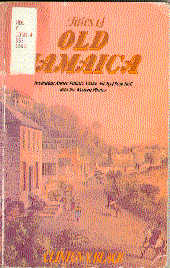
There are ten "tales" in this book, the most interesting of which from the genealogy point of view is "The Case of the Counterfeit Doubloons" because it describes how by using the archives in Jamaica, the man who did the counterfeiting was discovered. From the personal point of view I liked also the "The Woman Pirates" and "The Golden Table". Of course there is also the tale of Annie Palmer, the White Witch of Rose Hall and the Murderer Lewis Hutchinson of Edinburgh Castle.
Most people are not related to Lewis Galdy who was swallowed up in the 1692 earthquake in Port Royal and then thrown up again and lived 40 more years, (his tomb can be seen in Port Royal), but who knows about the others? Anyway the flavour of various times is richly portrayed in this little paperback book. Clinton Black was Archivist at the Archives in Spanish Town.
![]() The Maroons of Jamaica, 1655-1796: a history of resistance, collaboration and betrayal by Mavis C. Campbell.
Granby, Mass: Bergain & Garvey, 1988, 296pp.
The Maroons of Jamaica, 1655-1796: a history of resistance, collaboration and betrayal by Mavis C. Campbell.
Granby, Mass: Bergain & Garvey, 1988, 296pp.
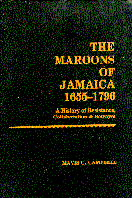
The Maroons are of interest in themselves, but because of the two Maroon wars (the only Wars fought on Jamaican soil) they influenced the settlement of the island and brought British military units to the Island.
The first maroons were the slaves of the Spaniards who escaped when the British conquered the island in 1655 and hid out in the sparsely inhabited interior. They were joined over the years by runaway slaves eluding efforts to recapture them until the end of the first Maroon war when the two main bands of Maroons in Portland (Nanny town) and St. Elizabeth (Accompong) made a treaty with the British to return runaway slaves to the properties in return for peace (1740). Relative peace reigned for over 50 years during which large areas were developed in sugar cane. But the new white settlers kept pushing back the enclaves of the Maroons and encroaching the terms of the treaty which resulted in the second Maroon War in 1795.
At the end of the second war, many Maroons were transported to Nova Scotia, Canada and finally to Sierra Leone in Africa. Some Maroons remained in the island in isolation and up to this day are not as integrated into the society as others. Mavis Campbell describes oral interviews which she had with some of the descendants.
![]() Jews, Slaves, and the Slave Trade: setting the record straight by Eli Faber.
New York: New York University Press, 1998. ISBN 0-8147-2638-0.
Jews, Slaves, and the Slave Trade: setting the record straight by Eli Faber.
New York: New York University Press, 1998. ISBN 0-8147-2638-0.
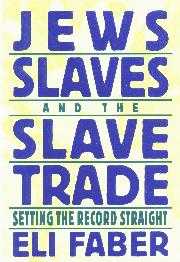
At first glance this book might not strike the Jamaica researcher as a useful source. Faber's purpose in writing the book was to answer accusations that the Jews had played a disproportionately large role in the slave trade and in slave ownership. Faber set out to answer these assertions using primary sources from the American Jewish Archives in Cincinnati, the American Jewish Historical Society, the British Library, the Calendar of State Papers and other sources in the Public Record Office, and most important of all, the Island Record Office and the Jamaica Archives and Record Centre in Spanish Town, Jamaica. He shows quite conclusively that, to the contrary, Jews played a very small role both in the slave trade and slave ownership, in comparison with non-Jews.
The book covers three West Indian islands, Jamaica, Barbados and Nevis, as well as in the mainland colonies, but it is the sections on Jamaica that are most valuable for Jamaicans researching their Jewish roots. While the main narrative itself is an excellent history of Sephardic Jewish settlement in Jamaica between the late 1660s and the 1820s, the appendixes are a gold mine of information, not easily obtainable, except by doing actual research at the Jamaican Archives. These appendixes, which make up half the contents of the book, include lists of names of Jewish Householders in the island, covering the periods 1680, 1740, 1745, 1769, 1795 and 1819.
Along with Jacob Andrade's History of the Jews in Jamaica, this book is one that any Jamaican Jewish researcher will treasure.
![]() Jamaica and Voluntary Laborers from Africa 1840-1865 by Mary Elizabeth Thomas. . Gainsville, Fl: University Presses of Florida 1974 211pp. ISBN 0-81 30-0438-1
Jamaica and Voluntary Laborers from Africa 1840-1865 by Mary Elizabeth Thomas. . Gainsville, Fl: University Presses of Florida 1974 211pp. ISBN 0-81 30-0438-1

A little known fact is that after Slavery was abolished in Jamaica in 1834, and apprenticeship in 1838, attempts were made to recruit paid labour from Africa. Between 1845-1865 it is estimated that about 10,000 were so recruited. They were promised repatriation after their terms of indenture, but often this did not occur. So some Jamaicans with African ancestors may not be descended from slaves, but from these labourers. This book chronicles the experiences of these workers in Jamaica and the colonial government which set the schemes up.
Since similiar schemes were in effect for Chinese and East Indian workers, those with such ancestry may also find this book of interest. A well documented history.
![]() The Story of the Jamaican People by Philip Sherlock and Hazel Bennett. . Kingston: Ian Randle Publishers Limited.1998. 434pp. ISBN 976-8100-30-3 (paper)
The Story of the Jamaican People by Philip Sherlock and Hazel Bennett. . Kingston: Ian Randle Publishers Limited.1998. 434pp. ISBN 976-8100-30-3 (paper)

This new book is a history of Jamaica from the African perspective. As such, it is a useful book, however the thing I found disappointing was that there are no new sources which are examined. Instead sources which constitute the bases for most Jamaican Histories with a European bias, are rehashed, except with an African persective. Since it is written really for a popular audience it does not have the documentation of most histories. Some modern poetry is used to illustrate points.
![]() Jamaica Talk: Three Hundred Years of the English Language in Jamaica by Frederic G. Cassidy. London: MacMillan & Cl Ltd. 1961, 468 pp.
Jamaica Talk: Three Hundred Years of the English Language in Jamaica by Frederic G. Cassidy. London: MacMillan & Cl Ltd. 1961, 468 pp.

This may seem an inappropriate book for family history, but it has several interesting chapters which pertain not only Jamaican vocabulary, but also some history in how practises have come down to us today. These include chapters on People: races and types, Domestic and Social Life I & II, eg. Food and culinary terms, Religion, Belief, Superstition and John Canoe and other entertainments.
The first four chapters contain Jamaicanisms, Sources of Jamaica Talk, Jamaican Pronunciation and Jamaican Grammar. A Word list is included, so if you have come across a term in some documents, this book may illustrate the meaning and origin of the term
![]() Twentieth Century Jamaica by H.G. Delisser. Kingston: The Jamaica Times, 1913. 208 pp plus advertizements and photographs.
Twentieth Century Jamaica by H.G. Delisser. Kingston: The Jamaica Times, 1913. 208 pp plus advertizements and photographs.
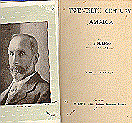
From the date you can see that this History of Jamaica only covers the first 12-13 years of the 2O th century inspite of the title. The author speculates on the future of Jamaica in the "new" century.
There is an interesting chapter on Obeah and one on religion. The tone of the book is very much from the colonolist point of view, but it does have some 1900's photographs and some very interesting advertizements especially from Kingston.
![]() World's Fair, Jamaica at Chicago: an Account descriptive of the Colony of Jamaica with Historical and other Appendies, compiled by C.J. Ward New York: Wm J Pell, 1893, 95 pp
World's Fair, Jamaica at Chicago: an Account descriptive of the Colony of Jamaica with Historical and other Appendies, compiled by C.J. Ward New York: Wm J Pell, 1893, 95 pp

Photographs made in the 1890's of the towns and countryside of Jamaica illustrate this slim little book which was written to encourage tourists and others to visit the island and presented at the World's Fair [Columbian Exposition] in Chicago in 1893. Jamaica was quite well prepared for this exhibition because it had had its own Exhibition in 1891.
The chapters include, a descriptive account of the parishes of Jamaica, Columbus and Jamaica, Later History, Sport in Jamaica, The Blue Mountains of Jamaica, the Climate of Jamaica and Statistical Information about Jamaica. I like this book chiefly for its wonderful black and white photographs of the 1890's
![]() In Miserable Slavery: Thomas Thistlewood in Jamaica, 1750-86. (Warwick University Caribbean Studies), by Douglas Hall London: Macmillan Publishers Ltd, 1989, 322pp. ISBN 0333-48030-9
In Miserable Slavery: Thomas Thistlewood in Jamaica, 1750-86. (Warwick University Caribbean Studies), by Douglas Hall London: Macmillan Publishers Ltd, 1989, 322pp. ISBN 0333-48030-9

Thomas Thistlewood an Englishman, lived in Westmoreland on a small estate with about 25-30 slaves. In his 10,000 page diaries he chronicled day to day living in Jamaica for 36 years. These diaries have been edited by Professor Hall and show the stark realism of slavery. It is interesting to contrast this book with the account of slavery and the plantation owners one can learn from the Craton's book on Worthy Park, a very large plantation with over 400 slaves. The size of Thistlewood's holding was more common in Jamaica, over 50% of holdings, whereas an estate the size of Worthy Park was less than 5% of all holdings. However because there are more records available from large plantations, we generally obtain a limited view of the typical slavery experience on the island. This book I think gives another impression about the lives of ordinary slaves in a more prevalent setting. It does not make the harsh realism of slavery any more palatable to the 21st century reader. Not an easy book for the sensitive to read.
![]() Port Royal, by Clinton V. Black
Kingston: Institute of Jamaica Publications Ltd., First published 1970, Revised edition 1988, 90pp ISBN 976-8017-06-6
Port Royal, by Clinton V. Black
Kingston: Institute of Jamaica Publications Ltd., First published 1970, Revised edition 1988, 90pp ISBN 976-8017-06-6

This book is a history and guide to Port Royal which was known in the 17th century as the wickedest city on earth because of its pirates. It became naval headquarters for the British Navy and Lord Nelson and others were stationed there. Some of the artifacts retrieived in 1965 from the sea where they were buried after the 1692 earthquake are illustrated in a chapter of the book. A map for a walking tour of the town is included.
Port Royal was also once a parish and extended up into what is now St Andrew. This book is on the historical town of Port Royal and the interesting people who populated it. Anyone who has ancestors from Port Royal should try to read this book.
![]() The Gleaner Geography and History of Jamaica: For use in Primary and Secondary Schools. , 21st Edition 1973 Kingston, Jamaica: UniPrint Ltd.98 pp
The Gleaner Geography and History of Jamaica: For use in Primary and Secondary Schools. , 21st Edition 1973 Kingston, Jamaica: UniPrint Ltd.98 pp

This book was used as a standard text in schools so it has an emphasis on events and dates in the section on History. It has few illustrations, mostly maps, one of which is a foldout 1962 road map, also a rainfall map and a geological map in the Geography section.
This 1973 edition contains references to the National Anthem, National Emblems (Flag, Coat of Arms and Motto, Flower, Tree, Bird, Fruit) and National School Prayer. Later editions exist. I also own a fourth edition when it was the Times Geography and History of Jamaica, published in 1944 prior to Independence. There is more narrative and less emphasis on dates but of course that edition does not cover modern events.
![]() Sojourners in the Sun: Scottish Migrants in Jamaica and the Chesapeake, 1740-1800, by Alan L. Karras Ithaca, NY: Cornell University Press, 1992, 231 pp. ISBN 0-8014-2691-X
Sojourners in the Sun: Scottish Migrants in Jamaica and the Chesapeake, 1740-1800, by Alan L. Karras Ithaca, NY: Cornell University Press, 1992, 231 pp. ISBN 0-8014-2691-X

This is a historical treatise comparing the Scots who went to Maryland as tobacco factors to the Scots who went to Jamaica as planters to the sugar estates. The title 'sojourners' is used because these immigrants did not intend to settle permanently in their respective destinations but rather to make their fortunes and return to their homeland and buy land to live in luxury. While some of the early sojourners to Jamaica achieved their goals most in the later part of the period covered did not. In fact they often could not extricate themselves from debt and lived out their lives in Jamaica.
For family historians there is an interesting chapter on the relationships, webs of patronage, between overseers or planting attorneys and the kin or friends that they sponsored on other sugar estates. One should keep in mind that the Scots of this period were not the only sojourners, many English and Irish had the same goals as the Scots in coming to Jamaica
![]() Jamaican Houses: a vanishing legacy text by Geoffrey de Sola Pinto, drawings by Anghelen Arrington Phillips Kingston: Stephenson Litho Press Ltd., 1982, pp 75.
Jamaican Houses: a vanishing legacy text by Geoffrey de Sola Pinto, drawings by Anghelen Arrington Phillips Kingston: Stephenson Litho Press Ltd., 1982, pp 75.
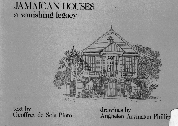
This book may at first appear inappropriate for a family history source, but if you want to know something of the architecture and building of the private and public buildings of the 19th centuryand earlier, this elegant series of drawings will give you a great overview. The drawings were made in the late 1970's and early 1980's so the buildings (there are 40) were still standing at that time.
The text which accompanies each drawing gives some history and a little genealogy of the ownership of private homes and for the public buildings such as a school, butchers shop and post office the date when built. The architecture is briefly described. There is a new edition.
![]() Jamaica: The Blessed Island by Lord [Sydney Haldane] Olivier. London: Faber & Faber Ltd, 1936, 466pp with black and white photographs.
Jamaica: The Blessed Island by Lord [Sydney Haldane] Olivier. London: Faber & Faber Ltd, 1936, 466pp with black and white photographs.
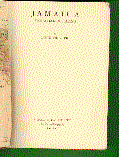
This author wrote about the rise of the Fruit Shipping companies (Bananas) in the late 1800's and early 20th Century and thus he covers a historical time in Jamaica which does not have a great deal of coverage. The photographs of the island are very interesting to see; most are contemporary of 1936, but others are photographs of historical prints.
My copy is annotated in pencil by my great uncle, R.M. Murray who was Headmaster of Jamaica College and Wolmer's Boys School which makes it very interesting. He was particular to point out where observations by Oliver were pertinent in the early part of the 20th Century. The fold out map is good for the illustration of mountains and plains of the island and the main towns and roads.
![]() The Killing Time': The Morant Bay Rebellion in Jamaica by Gad Heuman. Knoxville: University of Tennessee Press. 1994.199pp ISBN 0-87049-852-5.
The Killing Time': The Morant Bay Rebellion in Jamaica by Gad Heuman. Knoxville: University of Tennessee Press. 1994.199pp ISBN 0-87049-852-5.

This paperback book is an account of the 1865 Morant Bay (St Thomas in the East) rebellion. The book draws from documents made at that time including the Commission that was appointed to investigate the treatment of the rebels. It attempts to put the rebellion in the context of the time and the grievances of the people and the planters. The harsh reaction to the rebellion and the role of the Maroons is also treated.
The preface has portrait photographs of the chief participants in this historical event, Governor Eyre, Paul Bogle and George Gordon. Otherwise it is sparsely illustrated but well documented and two maps are included.
![]() A modern history of Thomas Coke, a prominent Methodist Missionary, 1747-1814 chronicles not only the life of Coke
A modern history of Thomas Coke, a prominent Methodist Missionary, 1747-1814 chronicles not only the life of Coke , but also the early years of the Methodist church, especially in Kingston, Jamaica called Thomas Coke: and the Early History of Coke Memorial Church, 1789-1839 by John W. Poxon 1989, 71 pp.
, but also the early years of the Methodist church, especially in Kingston, Jamaica called Thomas Coke: and the Early History of Coke Memorial Church, 1789-1839 by John W. Poxon 1989, 71 pp.
Published as a Bicentenary Publication by the Methodist District it may be difficult to obtain. This book unfortunately has no index, although the book mentions many parishioners by name. However it is rather short, only 71 pages so is not overwhelming to skim through. John Poxon was a Methodist minister and re-established York Castle School in Brown's Town, St. Ann in the 1950's.
![]() The most comprehensive book on Jewish Monumental inscriptions was published in 1997.by Barnett RD and Wright P.compilers. The Jews of Jamaica: Tombstone inscriptions 1663-1880. Jerusalem: Ben Zvi Intstitute. 1997 202 pp.ISBN 965-235-068-0.
The most comprehensive book on Jewish Monumental inscriptions was published in 1997.by Barnett RD and Wright P.compilers. The Jews of Jamaica: Tombstone inscriptions 1663-1880. Jerusalem: Ben Zvi Intstitute. 1997 202 pp.ISBN 965-235-068-0.
The material for this book was collected by Philip Wright in the 1960's by photograph and was retranslated (Hebrew Inscriptions) and checked from the gathered material for this edition. 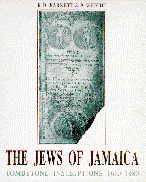 The inscriptions are from Hunt's Bay, Kingston, Spanish Town, Annotto Bay, St Ann's Bay, Falmouth, Montego Bay, Lucea, Savanna-la-Mar, Lacovia, and Rowe's Corner (Manchester) and amount to some 1456 inscriptions. As expected Kingston contributes the largest number to the total, since this is where most Jews lived and died. Note that this collection is comprised of inscriptions up to 1880. Andrade lists some that extend beyond that date in Kingston.
The inscriptions are from Hunt's Bay, Kingston, Spanish Town, Annotto Bay, St Ann's Bay, Falmouth, Montego Bay, Lucea, Savanna-la-Mar, Lacovia, and Rowe's Corner (Manchester) and amount to some 1456 inscriptions. As expected Kingston contributes the largest number to the total, since this is where most Jews lived and died. Note that this collection is comprised of inscriptions up to 1880. Andrade lists some that extend beyond that date in Kingston.
The older inscriptions are given in Hebrew and or Portuguese or Spanish, with headings in English that give the pertinent burial information. There are comprehensive indexes of names and dates. A few photographs are included with an aerial view of Hunts Bay cemetery in the introduction.
![]() A-Z of Jamaican Heritage. by Olive Senior Kingston: The Gleaner Company and Heinemann Educational Books (Caribbean) Limited 1983, 176 pp
A-Z of Jamaican Heritage. by Olive Senior Kingston: The Gleaner Company and Heinemann Educational Books (Caribbean) Limited 1983, 176 pp
 As suggested by the title, this book is arranged in the format of a dictionary or encyclopedia with paragraphs on such topics as Abeng, Accompong and Ackee to YS, Yassi and Zemi. Black and white pictures are included on nearly every page which enhances the information on the heritage of Jamaicans.
As suggested by the title, this book is arranged in the format of a dictionary or encyclopedia with paragraphs on such topics as Abeng, Accompong and Ackee to YS, Yassi and Zemi. Black and white pictures are included on nearly every page which enhances the information on the heritage of Jamaicans.
A subject index is included in the beginning of the book. A good source particularly for those who did not grow up in Jamaica, and may find words and customs difficult to find in typically abridged dictionaries.
![]() The Old Village and the Great House: an archaeological and historical examination of Drax Hall Plantation, St. Ann's Bay by Douglas V. Armstrong. Illinois: Urbana University Press 1990.
The Old Village and the Great House: an archaeological and historical examination of Drax Hall Plantation, St. Ann's Bay by Douglas V. Armstrong. Illinois: Urbana University Press 1990.
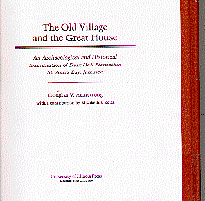
The examination of Drax Hall from archeological expeditions throws light on how the slaves lived in the villages on an estate, at least as far as can be deduced from artifacts gathered at the site. The contrast is made to the occupants of the Great House whose artifacts were also catalogued.
I think the book is important for genealogists because so few books tell us about the domestic life of the slaves on a plantation, e.g. what their homes were like, what they ate, how they lived from day to day, outside of the exhausting work. These artifacts tell us something of that aspect. Illustrated with drawings of house sites and artifacts.
![]() A Record of the Jews in Jamaica from the English Conquest to the present time. by Jacob A.P.M. Andrade. [ed. by Basil Parke] Kingston, Jamaica: Jamaica Times 1941, 282 pp, 2 maps.
A Record of the Jews in Jamaica from the English Conquest to the present time. by Jacob A.P.M. Andrade. [ed. by Basil Parke] Kingston, Jamaica: Jamaica Times 1941, 282 pp, 2 maps.
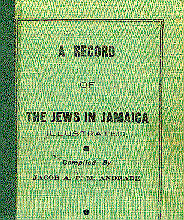
The most comprehensive inclusion of Jewish names is found in this 1941 book by Jacob A.P.M. Andrade. Besides the extensive listings of prominent men and women (mostly men), this book includes descriptions of Askzenasim and Sephardic synagogues and their paraphernalia, extracts of wills donating legacies to the synagogues and charitable institutions of the congregations as well as epitaphs and memorials in many of the places of burial of the Jews in Jamaica.
This book can be found in many research university libraries in the U.S., unfortunately it does not have a good index and no table of contents.
![]() Time Tells our Story: The History of Jamaica Mutual Life Assurance Society, 1844-1994. by Donald Lindo Kingston: Ian Randle Publishers. 1994. ISBN 976-8100-35-4.
Time Tells our Story: The History of Jamaica Mutual Life Assurance Society, 1844-1994. by Donald Lindo Kingston: Ian Randle Publishers. 1994. ISBN 976-8100-35-4.

This book recalls the people and events which led to the establishment of life insurance companies in Jamaica. A chapter on the history leading up to the start of life insurance companies in Jamaica is included.
In the appendices there are several lists of people and black and white photographs of places and people are included throughout the text. The general index includes many of the people mentioned. Donald Lindo worked for the company, retiring as Vice-President (Administration) in 1978. Great Job on the Book, Donald!
![]() Official and Other Personages of Jamaica, from 1655 to 1790, to which is added, a Chapter on the Peerage etc., in Jamaica, compiled from various sources. by Feurtado W.A. Kingston, Jamaica. W.A Feurtados, Sons 1896.
Official and Other Personages of Jamaica, from 1655 to 1790, to which is added, a Chapter on the Peerage etc., in Jamaica, compiled from various sources. by Feurtado W.A. Kingston, Jamaica. W.A Feurtados, Sons 1896.

This list is useful if you have got back into the 17th and 18th centuries in Jamaica. It covers especially the Members of the Assembly (M.A's) for the government, the military and naval officers as well as very well known people. At the beginning is a list of govenors, lieutenant govenors, judicary, secretaries, provost marshall's etc up to 1890's. The peerage section is interesting for leads you to other potential sources.
Feurtado did make some errors so it is wise to verify from other sources. This record is available on microfilm through Family History Centers in the Ellis Family Notes, letters and Pedigrees found in the British Film Area, but indexed under Jamaica.![]()
![]() Monumental Inscriptions of Jamaica by Philip Wright, compiler London: Society of Genealogists 1966 361 pp. Microfiche edition (Ref SoG/21) 1990 ISBN 0-946789-25-8
Monumental Inscriptions of Jamaica by Philip Wright, compiler London: Society of Genealogists 1966 361 pp. Microfiche edition (Ref SoG/21) 1990 ISBN 0-946789-25-8
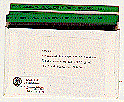
Monumental Inscriptions explores the records of burial and memorial monuments in churches, in church graveyards and those remaining on estates from the late 1600's to circa 1878. It has a few records from non-conformist churches, a few public burial grounds, but does not include Jewish burial grounds, nor will it include slave monuments since these were not made from permanent stone, but rather of wood, if at all.
The tropics has a climate which is not conducive to preservation of monuments outdoors and unfortunately many have deteriorated so as to be unreadable. The compiler drew on earlier works and attempted to verify the wording if the monument survived. An excellent index is included by parish, and this is the most inclusive of the monumental inscriptions which have been recorded in early Jamaica. This edition is on microfiche from the Society of Genealogists which made the fiche from the hardback book in 1990.
![]() Searching for the Invisible Man: Slaves and Plantation Life in Jamaica. by Craton, Michael Cambridge, Mass: Harvard University Press. 1978 439 pp ISBN 0-674-79629-2.
Searching for the Invisible Man: Slaves and Plantation Life in Jamaica. by Craton, Michael Cambridge, Mass: Harvard University Press. 1978 439 pp ISBN 0-674-79629-2.
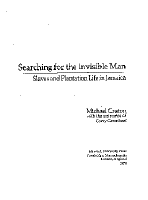
The book is based on the records of Worthy Park Estate in St Catherine, Jamaica. Worthy Park was one of the big estates in St Thomas in the Vale Parish at the time, now St Catherine, with over 400 slaves. Such estates constituted less than 5% of the total sugar estates in Jamaica, while estates with less than 50 slaves were over 50% of the total estates. So this estate cannot be considered typical of all estates. None-the-less because the records of few estates exist today, where they have survived like Worthy Park , 1780's - 1840's, we gain a great deal of information on plantation life and the lives of white and slave populations.
This book was written for the historian (and has some dry statistical sections) not the genealogist, however it has an excellent section "Individuals in Slave Society:Selected biographies", on traced slave families, which is continued in some cases to post-emancipation, 1834. Another chapter deals with the life of ordinary slaves, and another to non-conformist slaves. It shows what can be done if the records for the particular family is available, at least from 1817 when some slave records by name were kept. Before about 1817, it depends on having estate records such as those of Worthy Park. Some few of these could be in UK record offices, see Ingram KE Sources of Jamaican History [September 1996 Source on this page]. White residents are also treated, including the owners, overseers and book keepers. The book has good black and white illustrations which show life on the plantation
![]() Dictionary of Place-Names in Jamaica by Inez Knibb Sibley Kingston, Jamaica: The Institute of Jamaica. 1978, 184 pp plus index.
Dictionary of Place-Names in Jamaica by Inez Knibb Sibley Kingston, Jamaica: The Institute of Jamaica. 1978, 184 pp plus index.

The origin of the place names shown in maps of Jamaica is covered in this lovely little book Dictionary of Place-Names in Jamaica. Inez Sibley was the great grand daughter of William Knibb, a Baptist missionary who was an advocate of the slaves. This work is not just a list of place names but often contains snippits of genealogy which may be helpful. For example the lengthy description of May Pen opens “ MAY PEN, capital of Clarendon, was one part of a property owned by the Rev. William May, who was born in Ash, Kent, England in August, 1695, and educated at St John’s College, Cambridge. When he came to Jamaica, he was rector of Kingston Parish Church and then was transferred to Clarendon, where he served for 32 years. His first wife was [Smart] a daughter of Edward and Eliza Pennant, large landed proprietors in that parish. His second wife was Bathsuda, daughter of Florentius and Ann Vassal of the parish of St Elizabeth. MAY PEN.........”
Not all descriptions give as much as this introduction but I used it to illustrate the style of the book. Inez Sibley did extra research on Baptist Churches and Ministers so if your ancestors were Baptist, and particularly missionaries, this book is a must. A copy of the book is in the Family History Library at Salt Lake City, but I am not sure if it has been microfilmed.
![]() Tracing Your West Indian Ancestors: Sources in the Public Record Office. by Guy Grannum PRO Readers' Guide No 11. London, PRO Publications. 1995. 102 pp. ISBN 1 873162 20 0
Tracing Your West Indian Ancestors: Sources in the Public Record Office. by Guy Grannum PRO Readers' Guide No 11. London, PRO Publications. 1995. 102 pp. ISBN 1 873162 20 0

This guide from the Public Record Office (PRO) London (now the National Archives, Kew, London) has information on islands in the West Indies in addition to Jamaica. It includes sections on: Records in the colonial office, How people got to the West Indies, Life Cycle records, Census and other listings including wills, Land and Property, Military and related records, Slaves, The colonial civil servant and other items. The Guide is especially good in the military area of the British West India regiments and source references for information on the men who served. Well illustrated with examples of documents, this paperback book also gives postal addresses for West Indian Archives. It cost UK pounds 8.95 in 1996.
![]() Amercian Vital Records from the Gentleman's Magazine, 1731-1868. by David Dobson, compiler. Baltimore, Maryland:Genealogical Publishing Co Inc. 1987 310pp. ISBN 0-8063-1177-0. Typescript.
Amercian Vital Records from the Gentleman's Magazine, 1731-1868. by David Dobson, compiler. Baltimore, Maryland:Genealogical Publishing Co Inc. 1987 310pp. ISBN 0-8063-1177-0. Typescript.
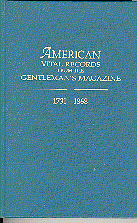
The title of this book is somewhat misleading, because a great many of the references are to Canadian and West Indian people. Especially after the American War of Independence the references to people in the United States are infrequent. Jamaica, Barbados and St Kitts have the most items, although St Vincent also occurs frequently.
These were alphabetical extracts from Gentleman's Magazine and concern births, deaths and marriages which were recorded in the original. Of course they pertain to Gentle men and women and few below that status are mentioned. Yet several persons rose to estate in Jamaica during that time by acquiring property and wanted to notify relatives back in England of the passage of vital events. Unfortunately the book is marred by typographical errors. I found many people of 125 years of age, and even one who was 147 years! You will want to verify the dates from the original magazine once you identify the volume and year reference which is given.
![]() Jamaica by K.E. Ingram World Bibliographical Series Volume 45. Oxford, England and Santa Barbara, California: Clio Press 1984 370 pp ISBN 0-903450-82-8
Jamaica by K.E. Ingram World Bibliographical Series Volume 45. Oxford, England and Santa Barbara, California: Clio Press 1984 370 pp ISBN 0-903450-82-8
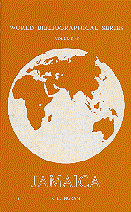
A modern bibliography of Jamaica this volume is number 45 in the World Bibliographical Series. It contains the most important contemporary as well as historical references to events in Jamaica.
Modern education, culture, trade, literature and political references are also contained in this volume. Ingram has annotated many of the citations included, which adds to the value for researchers looking for sources. Cross references are also given in various sections. This is the same author who wrote Sources of Jamaican History, see September, 1996 Source.
![]() Lady Nugent's Journal of her residence in Jamaica from 1801 to 1805. by Philip Wright. Kingston, Jamaica: Institute of Jamaica Fourth (revised) edition 1966 331pp
Lady Nugent's Journal of her residence in Jamaica from 1801 to 1805. by Philip Wright. Kingston, Jamaica: Institute of Jamaica Fourth (revised) edition 1966 331pp
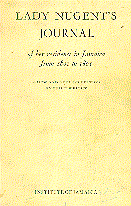
Lady Maria Nugent was the English wife of a Governor of Jamaica. She kept a detailed journal during her stay in Jamaica. The pages show her concern for the health of her family in the island, and her contempt for many of the lazy clergy she met. She made a trip around the island, meeting many people whom she describes with interest.
This revised edition has a person index, which is very helpful if you want to know more about the white population. Lady Nugent was a great name dropper in her journal and Wright has tried to identify many of the people. Lady Nugent comments frequently on the slave population, but not many individuals are mentioned. A map of her trip is included as well several plates depicting life in Jamaica at the turn of the 19th century.
![]() by History of the Catholic Church in Jamaica. by Francis J Osborne.Chicago, Illinois: Loyola University Press. 1988 532 pp. ISBN 0-8294-0544-5.
by History of the Catholic Church in Jamaica. by Francis J Osborne.Chicago, Illinois: Loyola University Press. 1988 532 pp. ISBN 0-8294-0544-5.
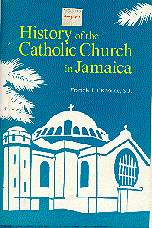
Father Osborne taught history at St George's College Boys School in Kingston. He was a member of the Society of Jesus from the New England Province. His book uses records in the Spanish Archives and covers the Arawaks and the Spanish occupation when the Catholic Church was the established church in Jamaica. After the conquest by England in 1655, the few Catholics languished in Jamaica without leaders, until refugees from Haiti in the beginning of the 1800's occasioned the Church to send missionaries to meet their needs. The book follows the re-establishment of the church until 1986. Although the names of parishioners are not mentioned frequently in this book, the difficulties which your Roman Catholic ancestors might have faced are well illustrated in these pages. The index does include a name index which includes the few parishioners, priests and educational missionaries.
![]() Naturalizations of Foreign Protestants in the American and West Indian Colonies. (Pursuant to Statute 13 George II, c7). by Giuseppi M.S., editor. Original published by The Publications of the Huguenot Society of London 1921. Reprinted Baltimore: Maryland, Genealogical Publishing Co Inc 1995. 196 pp. ISBN 0-8063-0157-0.
Naturalizations of Foreign Protestants in the American and West Indian Colonies. (Pursuant to Statute 13 George II, c7). by Giuseppi M.S., editor. Original published by The Publications of the Huguenot Society of London 1921. Reprinted Baltimore: Maryland, Genealogical Publishing Co Inc 1995. 196 pp. ISBN 0-8063-0157-0.
 In spite of its name, this list of naturalizations becomes of interest to those researching in Jamaica because it covers 152 Jews and 9 foreign protestants who were naturalized in Jamaica between June 1740 and May 1751. This occupies the first 6 pages of the book and the rest deals with Naturalizations in America, mainly in Pennsylvannia.
In spite of its name, this list of naturalizations becomes of interest to those researching in Jamaica because it covers 152 Jews and 9 foreign protestants who were naturalized in Jamaica between June 1740 and May 1751. This occupies the first 6 pages of the book and the rest deals with Naturalizations in America, mainly in Pennsylvannia.
However it is for the happy searcher of Jewish Jamaican Ancestry a good source. The country of origin is not given in the book, but the original PRO (The National Archives, Kew), records may have additional data. This book is also available on Microfilm through the Mormon Family History Centers around the world. Look in the Family History Catalog under Jamaica/Naturalization/ for the microfilm number to order.
![]() History of Jamaica. 2nd edition, by Clinton V. Black. Essex ; Longman Group UK Ltd. 1988 176 pp. ISBN 0582 03898 7
History of Jamaica. 2nd edition, by Clinton V. Black. Essex ; Longman Group UK Ltd. 1988 176 pp. ISBN 0582 03898 7

A short history of Jamaica from the Arawaks through Independence, this book is sold to the tourist trade in Jamaica. With many pictures and an emphasis on the people who shaped Jamaican history it is a quick study for those who are just beginning their family history search, as well as those who want a refresher on Jamaican history. Maps include: the areas of Africa from which slaves were drawn, Spanish occupation development of land, and old and present parishes and a map of the Caribbean islands included in the short lived Federation. A list of important dates is included. Clinton Black, the author was the government Archivist so had close contact with many original sources.
![]() Sources of Jamaica History 1655-1838: a Bibliographical survey with particular reference to Manuscript Sources. by Kenneth E.Ingram Switzerland and London, Inter Documentation Co. 1976 Two volumes, 1310 pages. Index in Vol II. ISBN 3-85750-017-4
Sources of Jamaica History 1655-1838: a Bibliographical survey with particular reference to Manuscript Sources. by Kenneth E.Ingram Switzerland and London, Inter Documentation Co. 1976 Two volumes, 1310 pages. Index in Vol II. ISBN 3-85750-017-4
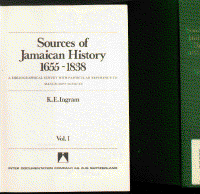
This two volume series was written by a relative who was a Librarian at the University of the West Indies, Mona, Jamaica. It has a good section on genealogy, and lists of holdings of the records in the Archives and Island Record Office in Spanish Town, Jamaica, however only up to 1838.
The strength is in the manuscript sources, mainly in Britain, although some in the United States and Spain are included. It is now out of print, so you will need to try a library, possibly a University Library.
Bonus: A Link to the UWI Mona Department of History. The University of the West Indies, Mona, Jamaica History Department has a page on the net.
![]() Slavery and Anti-Slavery History Link.
Slavery and Anti-Slavery History Link.
This is an digital history prepared by Steven Mintz. While it primarily deals with American Slavery many items pertain to West Indian Slavery also. There used to be a bibliography by Mintz but it is no longer on the site, at least I can not find it.
Slavery History-Digital History Site
![]() Jamaica Surveyed: Plantation maps and plans of the eighteenth and nineteenth centuries.by B.W. Higman Kingston, Jamaica. Intstitute of Jamaica Publications, Ltd. 1988 307 pp. ISBN 9768017058 Hardcover and 9768017082 (Paperback)
Jamaica Surveyed: Plantation maps and plans of the eighteenth and nineteenth centuries.by B.W. Higman Kingston, Jamaica. Intstitute of Jamaica Publications, Ltd. 1988 307 pp. ISBN 9768017058 Hardcover and 9768017082 (Paperback)

This book was based on a sub-sample (approximately 1000) of the 20,000+ estate maps and plans held by the National Library of Jamaica (formerly the Institute of Jamaica). In the introduction, surveying in Jamaica is reviewed and Jamaican surveyors and their business relationships are shown. A must if your family members were surveyors. Maps of different types of estates are covered: sugar estates, cattle pens, coffee plantations. The history and owners of each, where known, are included. On the maps, adjacent property owners may be named. Slave plots and names are shown in some estates. Some present day black and white photographs are included.
The icon used on this page is the bougainvillea flower.
![]()
![]() Return to Home Page. If you entered from the WorldgenWeb page, use the "Back" button on your browser.
Return to Home Page. If you entered from the WorldgenWeb page, use the "Back" button on your browser.